Following are many heartbreaking and poignant stories of the victims and survivors of the St. Francis Dam disaster.
Victims of the St. Francis Dam Disaster: A Comprehensive Listing
From the Fillmore American, Thursday, March 15, 1928, page 1
How Old Man Koffer Swept to Safety on Mattress of His Bed
Old Man Koffer was saved. And the term old is not used lightly or slurringly, for he is seventy-four. He and his wife, also aged, lived on the Carter Ranch above Fillmore. The waters caught them as they slept. And that is about all that Old Man Koffer remembers. For when he realized where he was, he was on his knees, clinging to the mattress, his old wife gone. A few awful moments and the mattress with its aged occupant was swirled out to one side and landed in the Illharaguy lemon orchard, where help came to him.
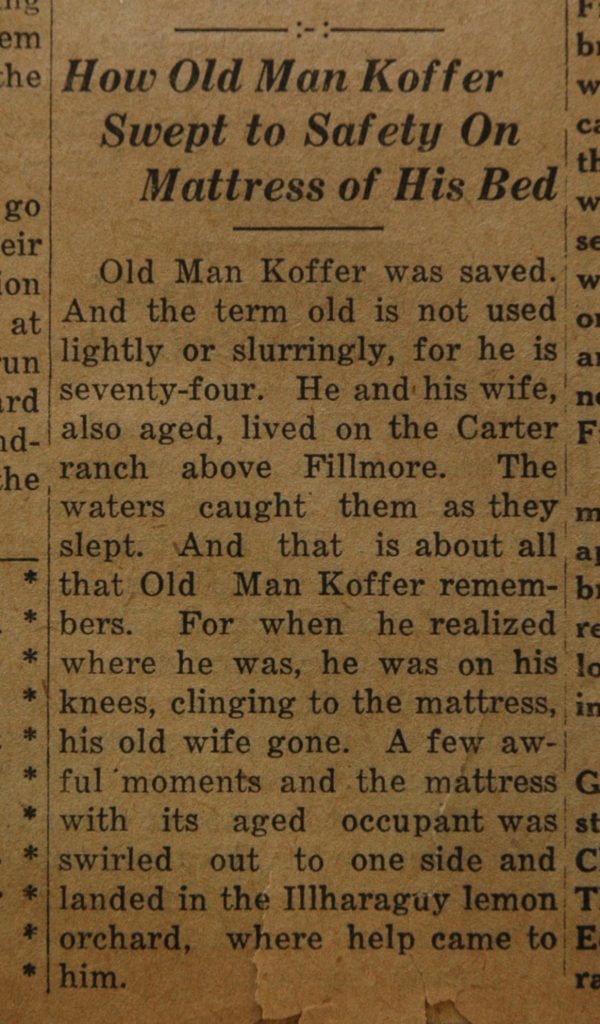
From the Fillmore American, Thursday, March 15, 1928, page 1
One-Legged Man Saved His Baby, But Lost His Wife and 4 Children
Hezikiah H. Kelly’s cup of woe is full and overflowing. A well known mechanic, he lost his leg some two years ago. For a year or more he has been operating a little ranch and raising rabbits on a tract south of the Bardsdale Bridge. When the waters struck he grabbed the baby, clung to a bit of drift, where he secured the child and was about to try to get back to his family. But Mrs. Kelly, little Harold, Phyllis, Dorothy and Dolores swept by, crying for help that could not come.

From the Fillmore American, Thursday, March 15, 1928, page 1
Only One of Gordon Cummings Family of Four Now Alive
Gordon Cummings was a member of a well known Fillmore family. His own family consisted of his wife and two young daughters. One of these was the relatives last Monday night. Gordon loaded his wife and daughter in a car. The car was caught in the swirling waters and all three perished.

From the Fillmore American, Thursday, March 15, 1928, page 1
Shot His Way Out Thru Roof of House, Saved by Sycamores
Frank Maier and his wife and three children, residing on a ranch below the Bardsdale bridge, had a remarkable escape. As the waters swirled in around them, they made their way to the attic. Here Frank shot a hole through the roof, through which he passed his wife and two of the children to the roof. As he was about to follow them with his son, the house began to move. It was caught in a little circle of sycamore trees, where it rocked from side to side, without turning over or being carried away. The house floated, like a leaky boat, the mark showing that there had never been more than eighteen of inches of water in it, when it dropped back to the ground.
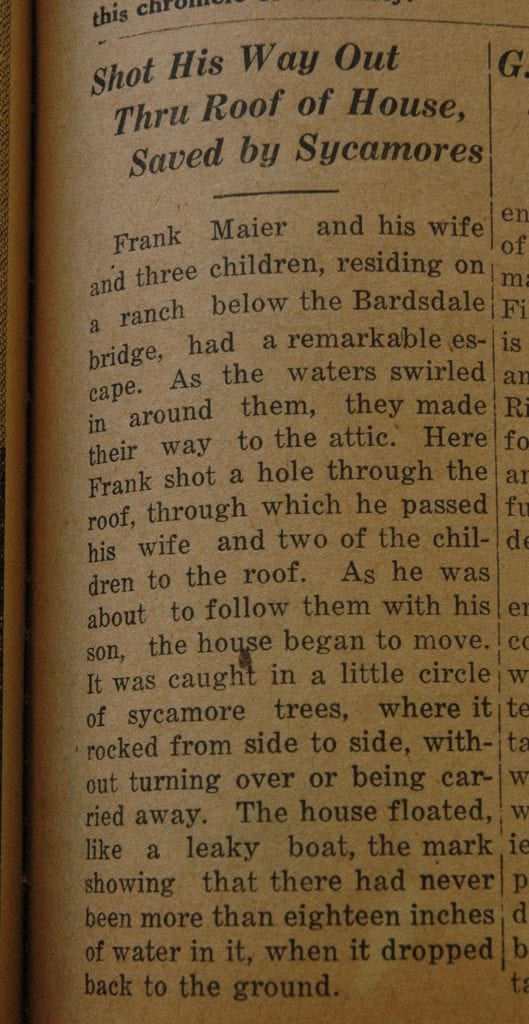
From the Fillmore American, Thursday, March 15, 1928, page 4
A watch on one of the Edison men, who was drowned at the Edison construction camp east of Piru, had stopped at 1:24.
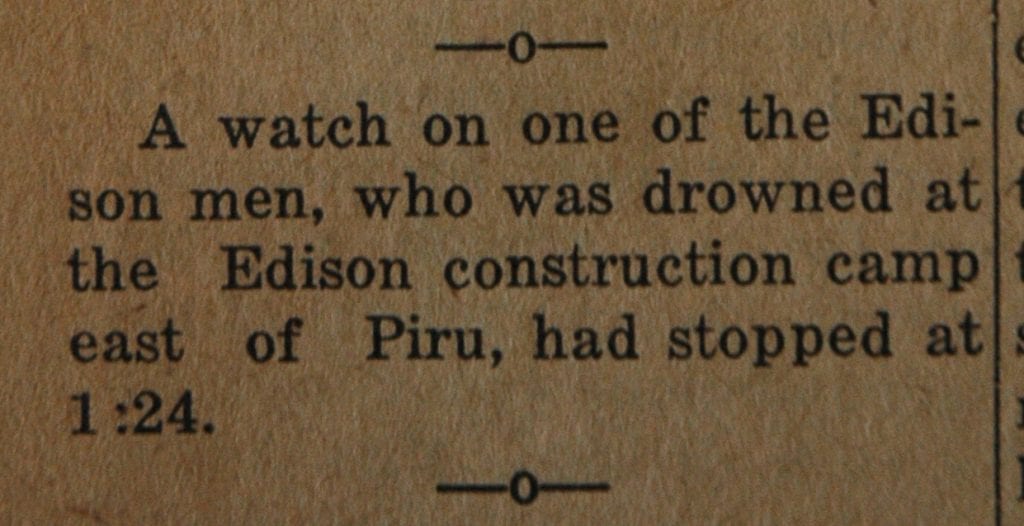
From the Fillmore American, Thursday, March 15, 1928, page 4
Father John Joseph Cox, of Santa Paula, who has been the busiest of all busy men since the disaster, identifying parishioners, consoling grief stricken relatives, arranging for the last sad rites over victims, this morning had the enjoyable task of christening a wee babe, born at the clinic to Mrs. Luna, the Mexican woman who paddled herself and three small children, none over three years of age, to safety on a mattress.

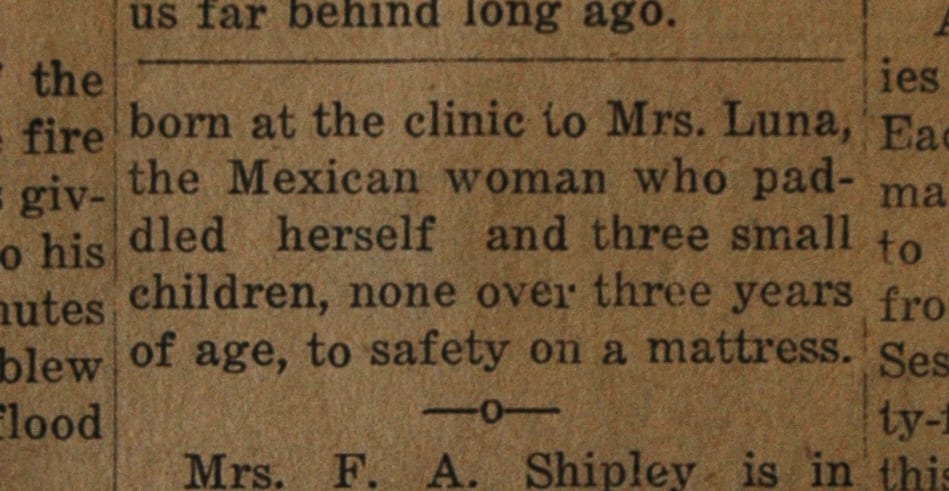
From the Fillmore American, Thursday, March 15, 1928, page 4
First Fillmore Funeral Has Been Set for Friday at Bardsdale
With the inquests in progress over the county on Thursday, there came the first announcement of a funeral. The bodies of Mr. and Mrs. Gordon Cummings will be laid to rest at two o’clock Friday afternoon. Owing to the impossibility of getting across the river to a church, the services will be held at the cemetery and will be conducted by Rev. G.U. Gammon, of the Presbyterian church.
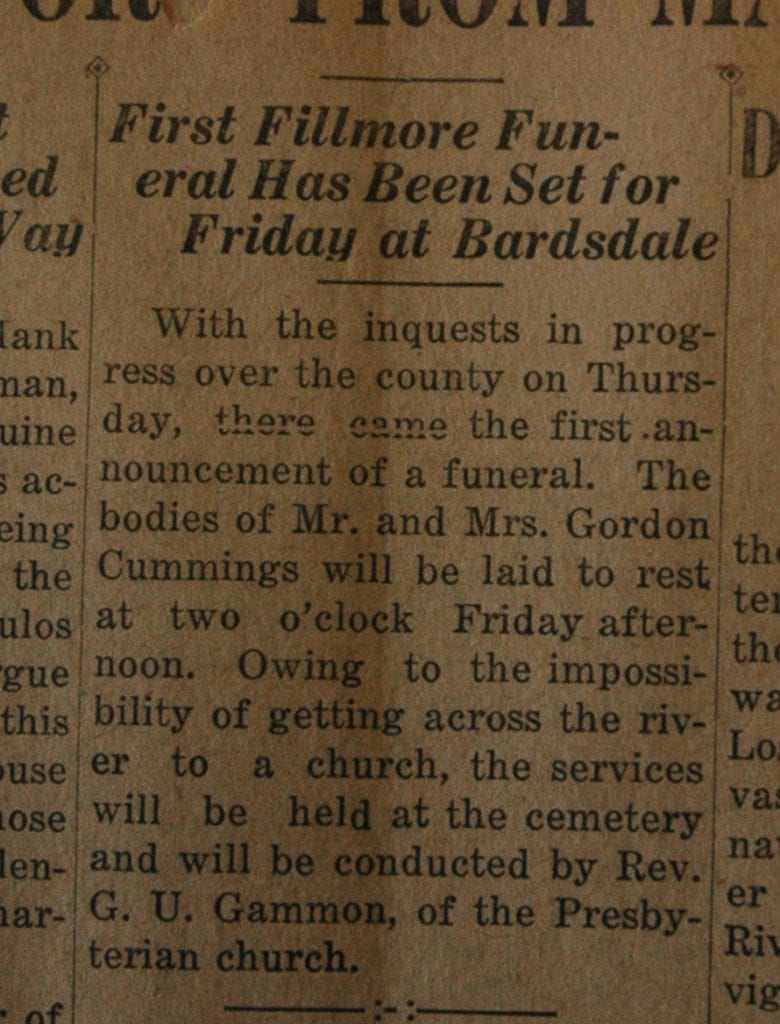
From the Fillmore American, Thursday, March 15, 1928, page 4
The Kern county officers rushed to the scene of the disaster, and took injured and dead bodies in their cars to Bakersfield, as all roads south and west were cut off. There are at least four known dead in the the central city.
Mr. and Mrs. B. de Hoyos gave invaluable aid during the past few days throughout the devastated district, as they speak Spanish fluently and understand the needs of the Mexicans as well as a Mexican would.

From the Fillmore American, Thursday, March 15, 1928, page 4
The French and Skillin undertaking parlors at Santa Paula last night had fifty-one corpses laid out in splendid shape, embalmed and lain so that identification could be made easily. Embalmers arrived last night from Santa Maria, San Luis Obispo, Santa Barbara, and points south to help Mr. Skillin with his work. Right here a word should be said for the fine manner in which Mr. Skillin handled the emergency. He assumed a great responsibility and supervised the ghastly work without hesitancy. The task of caring for the dead from this time on will present a great problem.
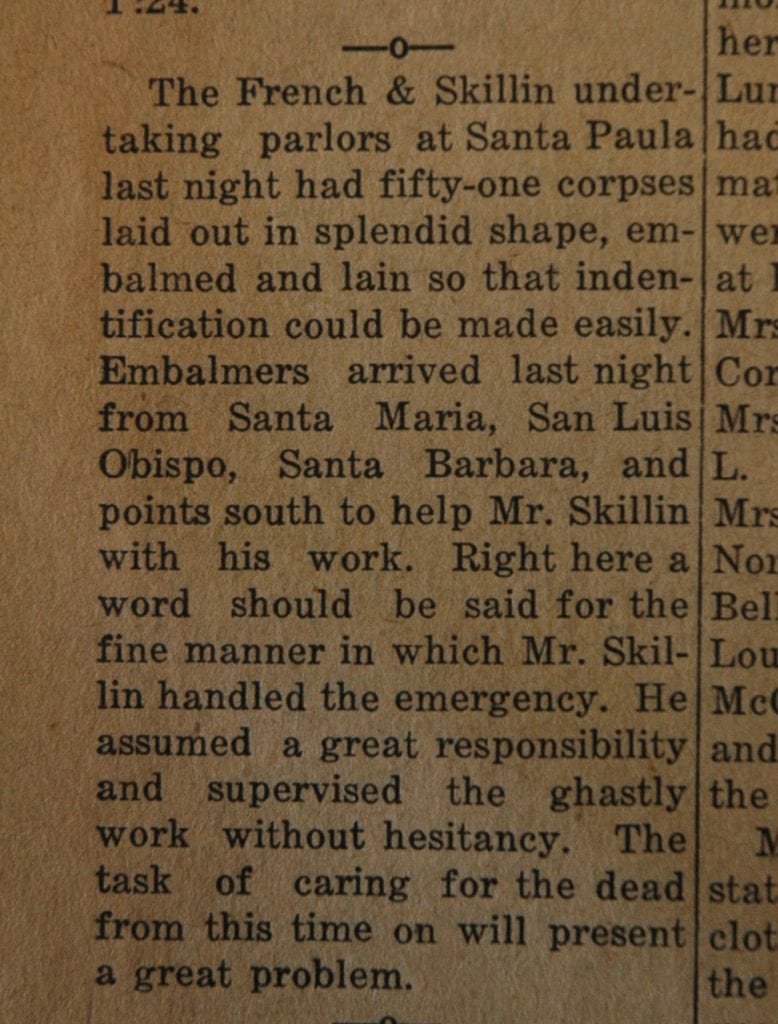
From the Fillmore American, Thursday, March 15, 1928, page 4
How Manuel Reyes Awoke Just in Time to Save His Family
Manuel Reyes is editor and the entire mechanical force of “La Voz de la Colonia”, the Spanish paper printed in the office of the Santa Paula Review. Monday night he was working the night shift on the big Intertype. At midnight the lights went out. He sat down, as many of us have done before, to wait for the lights to come back. He was wakened by the blowing of the police sirens. Hearing of the danger, he jumped on a police car and was rushed down below Harvard Boulevard, where his house was located. He just had time to get his own folks, and to shout a warning to a few neighbors, when the water came. His neat little bungalow, all his household goods, and all the clothing of the family, save what Mr. Reyes and his wife wore, were swept completely away.

From the Fillmore American, Thursday, March 15, 1928, page 4
How the Boardmans Met Their Tragic Fate in Santa Clara
G.P. Boardman, one of the best known men in the Fillmore-Bardsdale district mourns the loss of his wife and daughter, Florence. He and his young son were sleeping in a separate house. He heard the roar of the oncoming waters. As he stepped outside, the waters struck. His son had followed him out. He grabbed his son and clung to a bit of drift. The main house was going. Mrs. Boardman and her two daughters, Florence and Bernice, were on the roof, only the Lord knowing how they got there. Boardman and his boy were swept along until cast up on the south side, and completely nude, made their way to the Burson ranch below. In the meantime the house went on until it struck the Bardsdale bridge and went to pieces. Mrs. Boardman and her daughter, Florence, were drowned. Bernice caught in a tree further down and was rescued later on.

From the Fillmore American, Thursday, March 15, 1928, page 4
Knights of Pythias Are Able to Care For All of Their Own
Every fraternal organization in the country is getting into touch with their brothers in the stricken field. The Los Angeles lodges of the Knights of Pythias had a delegation in Santa Paula and Fillmore on Wednesday to see if aid was needed. The delegation was headed by S. McClure, supreme lodge representative; Any Francisco, Peter Powelson, John Tweedle and Charles Stansbury. They were assured that should any need arise among Ventura county Pythians they would be cared for by the lodges of the county.

From the Fillmore American, Thursday, March 15, 1928, page 4
Little Progress in Cleaning River Bottom is Being Made
The progress of cleaning the piles of driftwood along the river in the Fillmore district is proceeding slowly. Wednesday almost 600 men were out, under the direction of the Service Club. But the work of clearing the drift away was slow and heart-breaking. Tractors were used wherever possible. Seven tractors and crews worked all day Wednesday, clearing the highway south of the approach to the Bardsdale Bridge. Along the north side of this highway were the four houses of the Basolo families, three of which were swept away. It was an all-day job to clear this short stretch of road, and no bodies were found there. Thursday morning an equal body of men went out, somewhat better provided with equipment. Boy Scouts were patrolling the long stretch of river bottom searching for the bodies of dead animals. When one was found a white flag was stuck in the ground. Another party followed with large supplies of oil and these bodies were destroyed by fire to prevent the spread of contagion. A mass meeting was held at Fillmore at 1:30 Thursday afternoon at which pleas were formulated to be presented to both state, county, and Red Cross headquarters. Fillmore wants its debris cleaned up and all bodies recovered. And is unable to finance this alone. It needs money and it needs equipment–AND IT NEEDS BOTH OF THEM NOW.

From the Fillmore American, Thursday, March 15, 1928, page 4
Men Whose Respect For Humanity Moved Them The Right Way
Over at Fillmore, Hank Stearns, the theatre man, proved that he was a genuine lover of humanity. He was active in every relief work, being among the first to reach the temporary hospital at Camulos Ranch. And while the morgue was full of dead, and all this section dark, he kept his house dark out of respect to those who mourned. It was a splendid thing reflecting the character of the man.
James Ispwich is another of nature’s noblemen in the Fillmore section. Practically all his establishment remained closed on Tuesday. But on Wednesday he opened that his place might be used as an unofficial bureau of information. But the pool and billard tables remained covered. And Roberts of the other pool hall followed in his footsteps.
The West Coast house in Santa Paula “did business” as usual. These big corporations can be relied upon to keep raking in the nickels without regard to either public or private sorrows. Of course this stricture only applies to the controlling corporation and its higher ups, far from the scenes of sufferings. The local manager, Lou Baumgarter, has been untiring in his efforts along local relief lines.

From the Fillmore American, Thursday, March 15, 1928, page 4
The body of Mrs. Holt was found at Ventura yesterday, that of her mother, Mrs. Whiteside lying in Santa Paula at the French and Skillin funeral parlors.
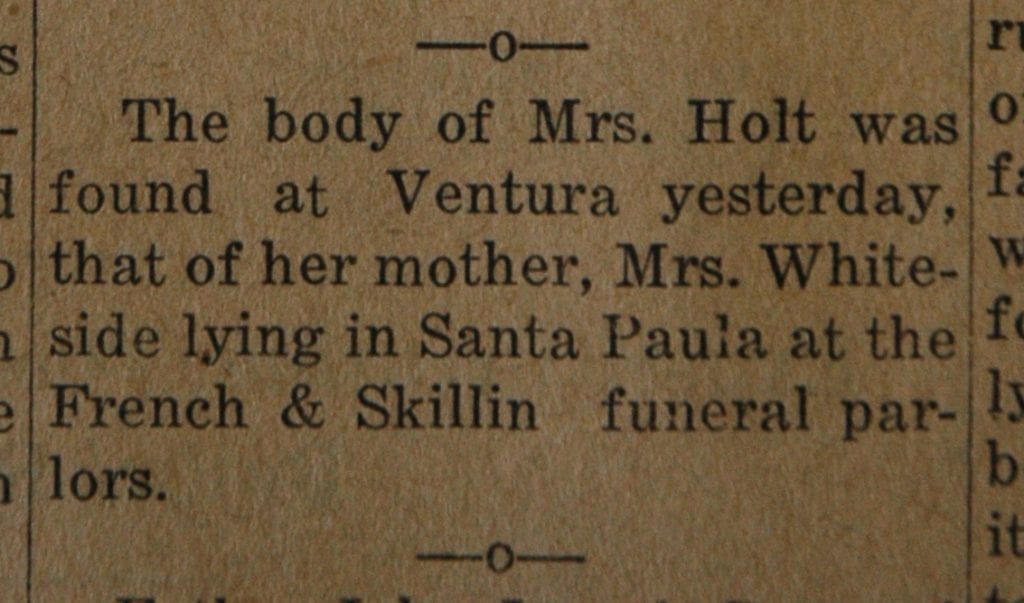
From the Fillmore American, Thursday, March 15, 1928, page 4
New York Paper Wanted Eye-witness Account of Flood
Great interest was taken in this awful calamity all over the country. Naturally the big metropolitan papers wanted the most complete coverage they could get on the story. Wednesday night the following query came through from New York:
“William H. Miller, American, Fillmore, Cal.:–John Nicholas Beffel tells us you may be in position to give eyewitness account of flood. If you can would appreciate two thousand words just what you saw and experienced. The World”.
Beffel, one of the best known newspaper men in New York, began his newspaper career on a paper in Illinois with the editor of the American and Review–a younger man, he left us far behind long ago.
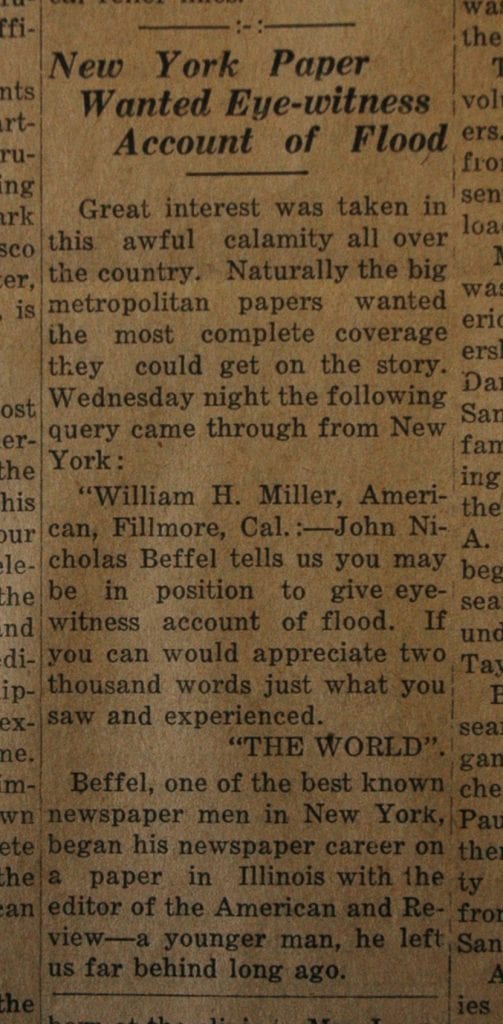
From the Fillmore American, Thursday, March 15, 1928, page 4
Offers of Help Are Pouring In From All Sections of Country
Practically every organization represented in Santa Paula, Fillmore and Piru districts has heard from its state officers or governing bodies, offering relief, or asking what they can do to help.
District Governor Al Roth of Rotary was among the first to wire. Individual Rotary clubs have sent word, and unsolicited more than $400 has come in from these various Rotary clubs in cash.
In spite of which this whole section needs cash, and NEEDS IT NOW. And no false pride should prevent our letting that thing be known.
H.K. Mulford Co., one of the great manufacturing chemists of the country, sent into this district on Wednesday a supply of all sorts of antitoxins and serums used in preventative medicine. The total value of their gift was $5,000. Parke Davis & Co., another big concern in the same line, made a substantial contribution of the kind.
Sears Roebuck and Co. sent trucks into the district, leaving contributions of clothing, underwear and blankets at every Red Cross depot in the flooded district. And at each stop they also subscribed $25 in cash.
But local merchants everywhere had been doing the same thing with limitless generosity before the mail order men showed up. In Santa Paula, W.E. Cooney brought load after load of such things to Red Cross headquarters.
Also Ely Kaplan contributed 100 pair of shoes.

From the Fillmore American, Thursday, March 15, 1928, page 4
Work of opening Harvard boulevard commenced Tuesday afternoon under the supervision of Street Commissioner Charles Millard as soon as the water was off the street. Willard Carrier’s home was left on the street, completely blocking all traffic. With the aid of big tractors, this and other obstructions were removed and this important thoroughfare was opened Wednesday.
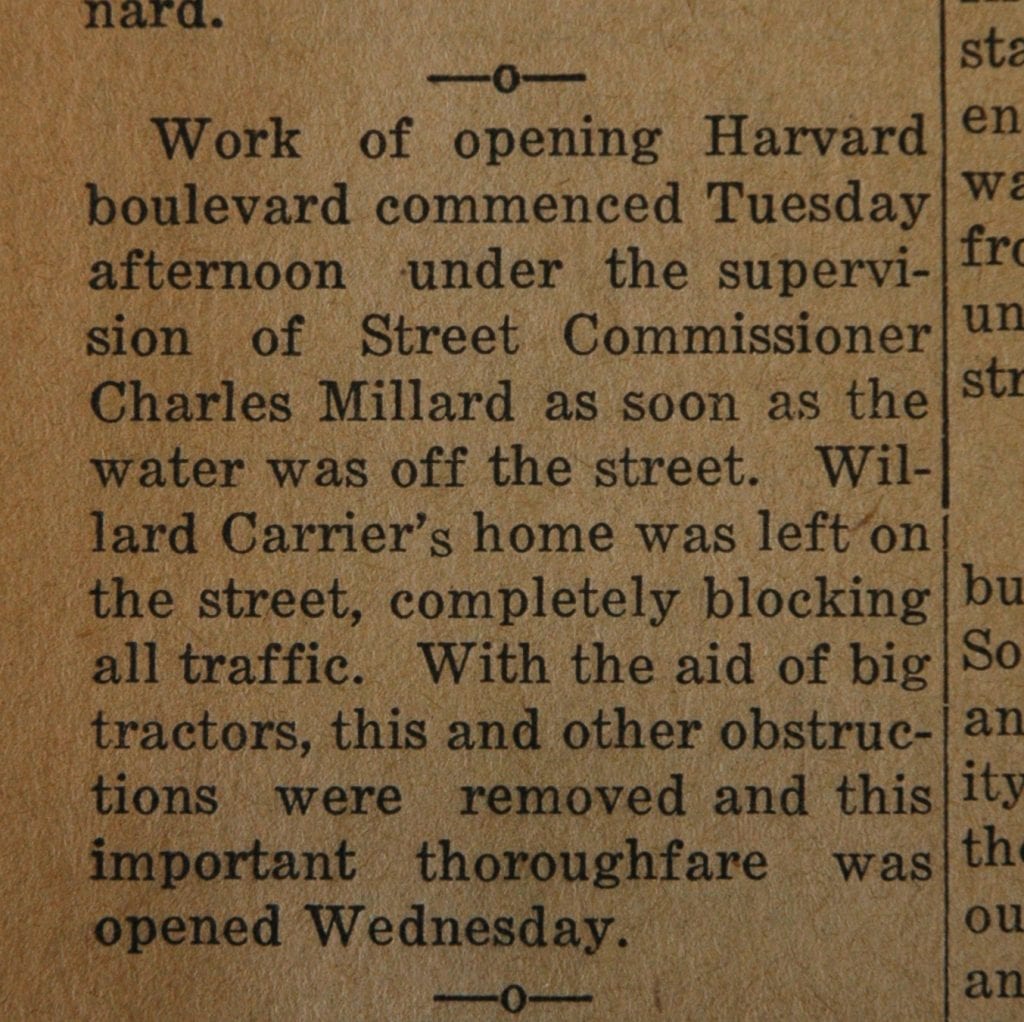
From the Fillmore American, Thursday, March 15, 1928, page 4
As an attest of the almost universal sympathy and generous impulses awakened in the hearts of the people by this terrible catastrophe to our beautiful valley, came this telegram to C.M. McCool, of the Quick-Print Shop: “We stand ready to furnish you immediately with any printing equipment we can at our own expense to help you at this time. Please reply. Miler Saw Trimmer Co.” This well known house carries almost complete printing equipment, so the magnanimity of the offer can readily be appreciated.
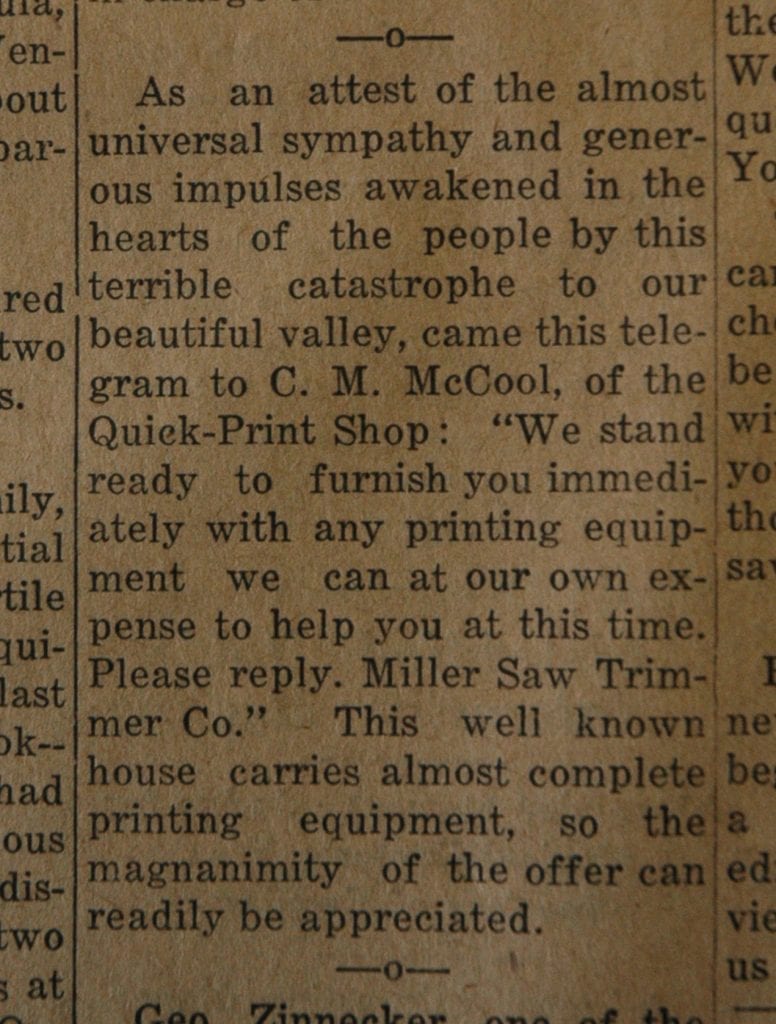
From the Fillmore American, Thursday, March 15, 1928, page 4
Public Utilities Did Splendid Work Restoring Service
Following the going out of the dam, all the section of country was thrown into darkness by the breaks in high power lines leading into the valley. But the Edison company snapped into action instantly. And within a very few hours the service was restored.
Even before daylight came, the crews of the telephone companies were out and at work restoring the means of communication from point to point.
At Santa Paula the breaking of the pipe line left the town without gas. But by mid forenoon service in this line was also restored. Fillmore fared better in this respect, at no time being without gas. This also applied to the Piru section. The supply of gas for the Fillmore section comes more particularly from the Montebello oil field.

From the Fillmore American, Thursday, March 15, 1928, page 4
A cousin of the Ruiz family, a group of sixteen substantial citizens who lived in the fertile through narrow San Francisquito valley, was in town last night from San Fernando looking for his relatives. He had found eight bodies at various morgues in the devastated district, two in Santa Paula, two in Fillmore, and the others at Newhall, Moorpark and Oxnard.
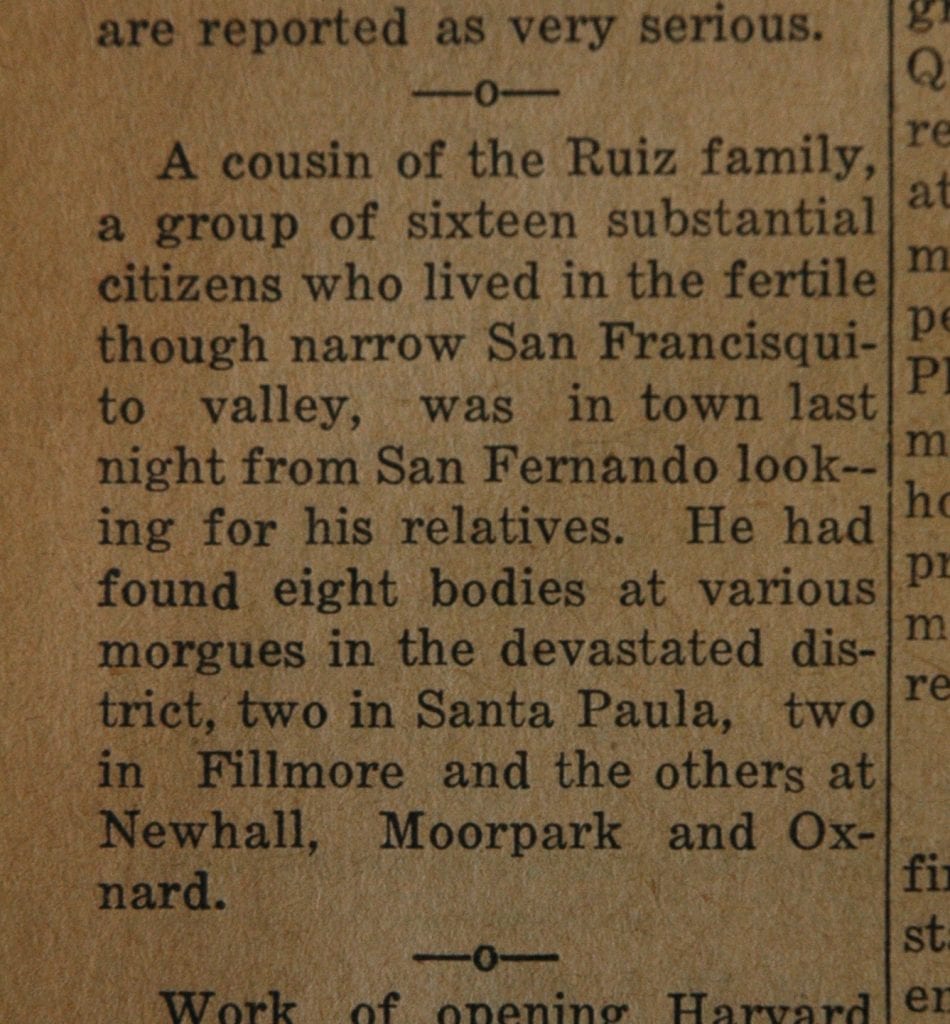
From the Fillmore American, Thursday, March 15, 1928, page 4
The past two days have been busy ones for folks living on South Seventh, South Fourth and other streets in that vicinity, who have been salvaging their household goods, washing out the mud from their homes and drying their bedding and clothing.

From the Fillmore American, Thursday, March 15, 1928, page 4
Search for Bodies Started Tuesday Is Still Continuing
The work of recovering the bodies of those lost was begun at once. In Piru the recovered bodies were cared for at the Riverside dance hall. At Fillmore, the French and Skillin undertaking headquarters were turned into a temporary morgue. At Santa Paula, a temporary morgue was established opposite to the city hall. During the day more than a hundred bodies were recovered and taken to these various places. More than twenty of these bodies were taken across Grimes Grade to Moorpark. These were victims from Bardsdale, and further up the stream, and whose remains it was impossible to take across the river at Fillmore.
There were hundreds of volunteer searchers and workers. The big oil companies from Ventura and other points sent truck loads after truck load of men.
Much of the first day’s work was haphazard. But the American Legion, under the leadership of Commander David Darling swung into action at Santa Paula. At Fillmore, the famous Service Club (containing many Legionaires) under the leadership of President R.A. Fremlin, early in the day began to function. The active search during the first day was under direction of Arthur W. Taylor.
By Wednesday morning, the search was systematically organized. Over 500 men were checking into search at Santa Paula. More than half of them were from Ventura County Post. The remainder were from Posts in Los Angeles and Santa Barbara counties.
At Fillmore the search parties were divided into squads. Each squad had a leader and a map of the territory they were to cover. The entire section from Piru to the mouth of the Sespe were covered, with twenty-four men to every mile of this territory and a foot by foot search began. A commissary camp for these workers was established in the city park.

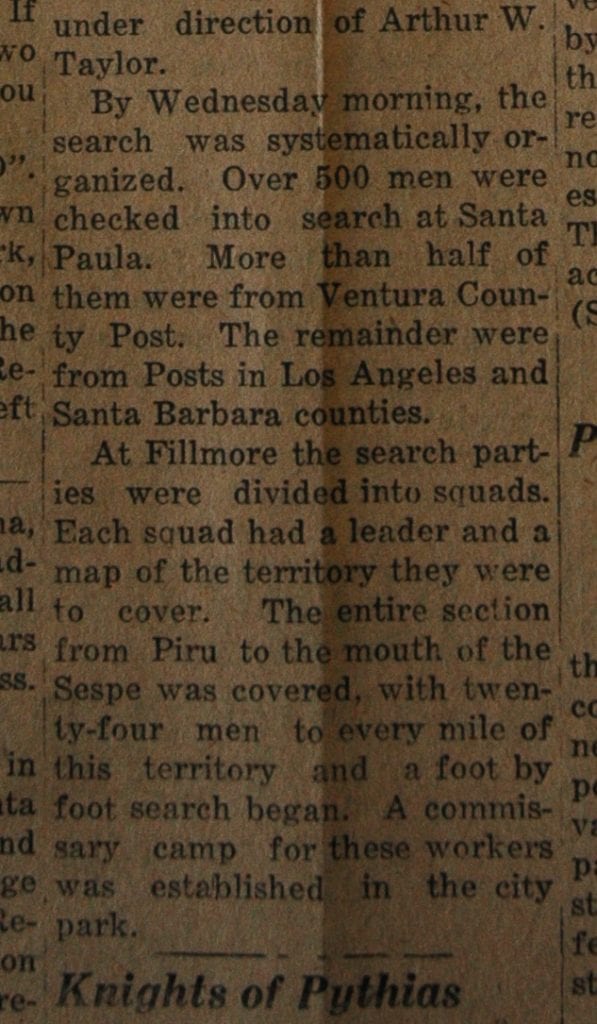
From the Fillmore American, Thursday, March 15, 1928, page 4
Mrs. F. A. Shipley is in charge of “help” at Santa Paula relief headquarters, and Mrs. T.L. Millham has charge of the kitchen. Today the Rebekahs, under the supervision of Mrs. A.F. Harms, are preparing the food, which is proof sufficient that it is delicious.
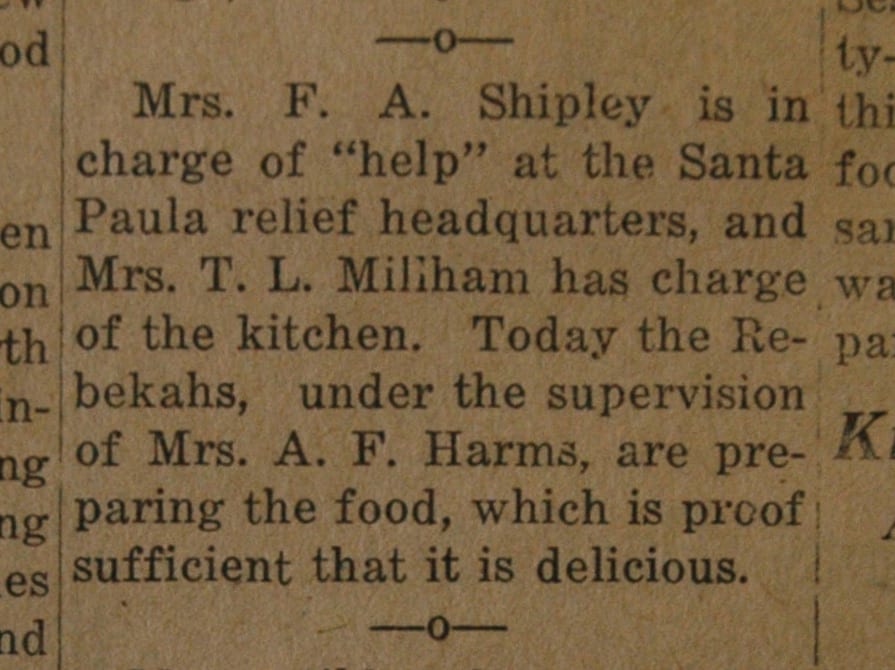
From the Fillmore American, Thursday, March 15, 1928, page 4
The Castaic Junction Was Swept Clean as The Floor of a Barn
The junction of the Ridge Route and the county highway was a busy place, with big filling station, restaurant, tourist cabins and the quarters of the Southern Pacific section crew, Wonderful alfalfa fields were spread over hundreds of acres.
The service station was operated by R. McIntyre, who lived there with his family. All were lost. The bodies of McIntyre and two of his sons were recovered and identified at Santa Paula, their former home where he was well known. Before opening the station at Castaic, he was employed from years at Oak Ridge.
The restaurant was operated by a Mr. and Mrs. Jones. The body of the man identified at Fillmore on Wednesday night, by a daughter from San Diego. At this writing she has not yet succeeded in locating the body of her mother.
Of the men and women living in the quarter of the section crew there, only one is aid to have escaped. The bodies of the others have not yet been identified.
Among identification made at Fillmore was that of the manager of the Harry Carey ranch. This attractive place was completely wiped out.

From the Fillmore American, Thursday, March 15, 1928, page 4
The little Hoppie boy, about 8 years old, from Santa Paula, was found in the ocean at Ventura yesterday afternoon about 4 o’clock. No trace of his parents has been found.
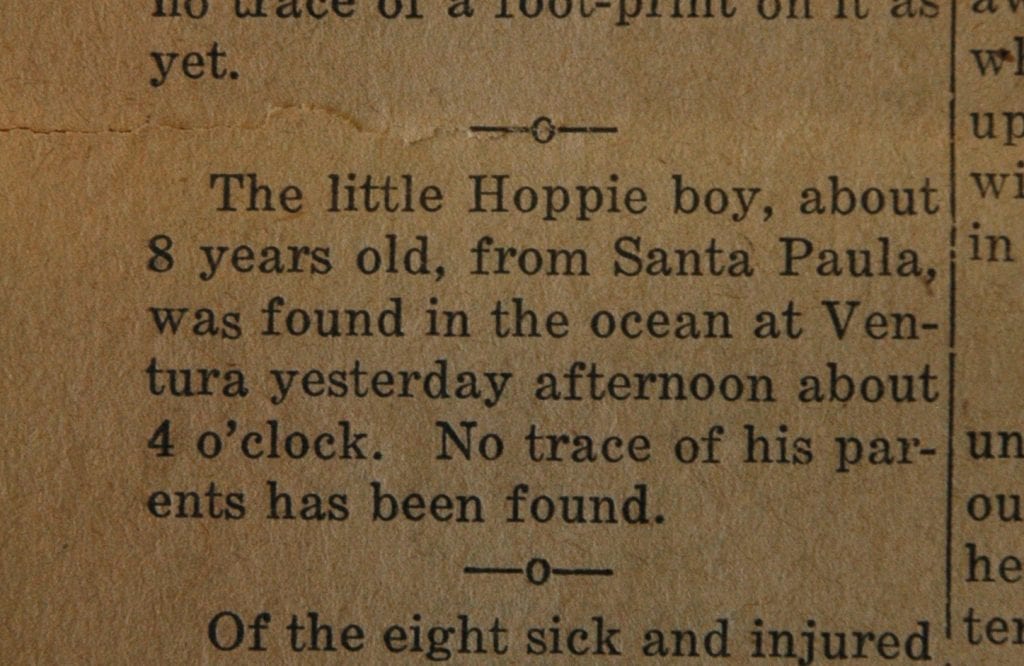
From the Fillmore American, Thursday, March 15, 1928, page 4
Geo. Zinnecker, one of the first firemen to reach the fire station after the alarm was given, states that, according to his watch, it was just 45 minutes from the time the siren blew until the crest of the flood struck the Willard bridge.
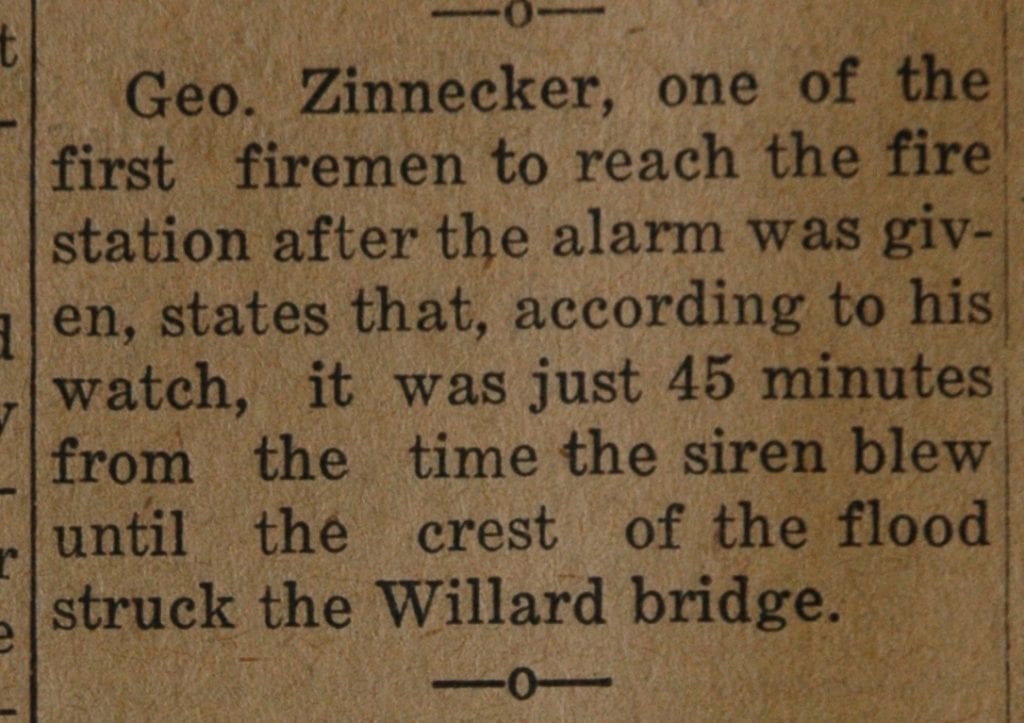
From the Fillmore American, Thursday, March 15, 1928, page 4
Many wild and preposterous rumors are being circulated–one about a six-month-old infant being found alive and well who had been in the mud over forty hours, being self-evidently false. Many miracles have been recorded, however, and it is to the police force and motor “cops” of the county that one of the biggest votes of thanks should go for their persistent warnings before the deluge came.
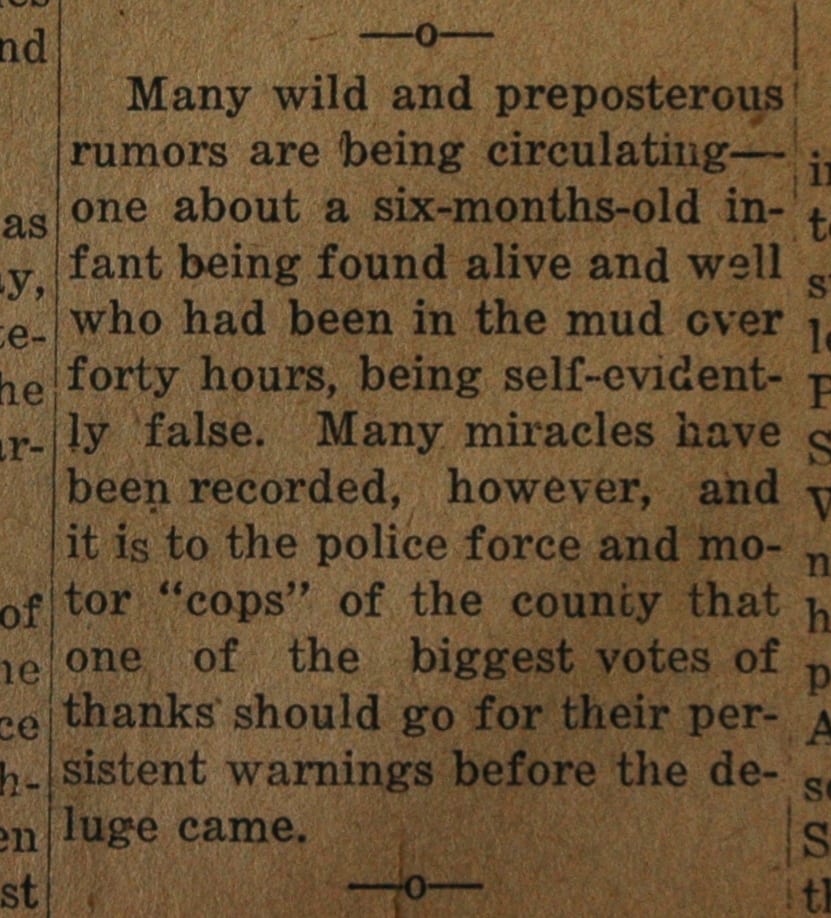
From the Fillmore American, Thursday, March 15, 1928, page 5
Accidental Drowning Found at Inquests
Ending the inquests in Ventura county this afternoon came when inquests were called at Oxnard and Santa Paula simultaneously at 2 p.m. The jury in this city at press time, was still checking names, though it was believed at the end of the jury’s findings would be the same as in the other cities, “death by accidental drowning.”
A little group of less than 20 men, today met in Moorpark dance hall and heard the verdict of the coroner’s jury that nine residents of the Santa Clara river valley, whose bodies rested in an improvised morgue, met their death through “accidental drowning due to the breaking of the St. Francis dam.”

From the Fillmore American, Thursday, March 15, 1928, page 5
BEWARE AMBULANCE CHASERS!
They are already in the coun-cal committee. Let the entirety. Place no damage case in flooded area proceed against the hands of any contingent the parties responsible–when fee attorney. Consult your lo- that is determined–as a body!
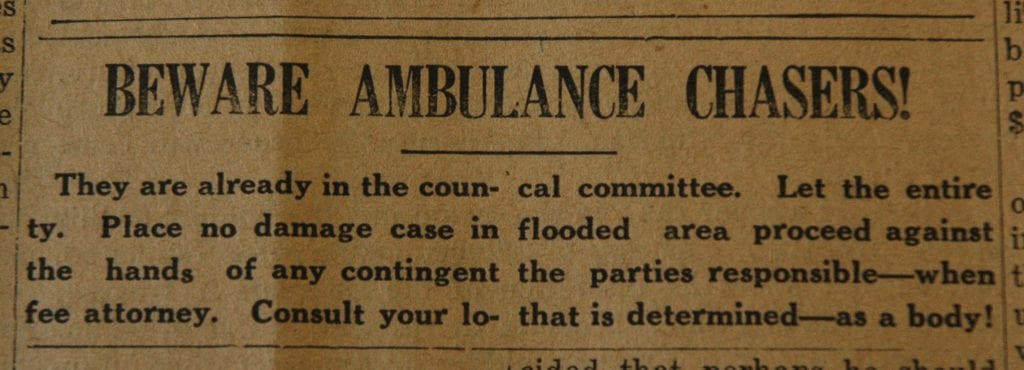
From the Fillmore American, Thursday, March 15, 1928, page 5
Cowden Family Wiped Out by Flood at Their Ranch in Bardsdale
Earl Cowden, cousin of the well known real estate men of Santa Paula, had but recently moved onto a ranch in the Bardsdale district. The entire family, father, mother, and four children, all perished. The bodies of all have been recovered.
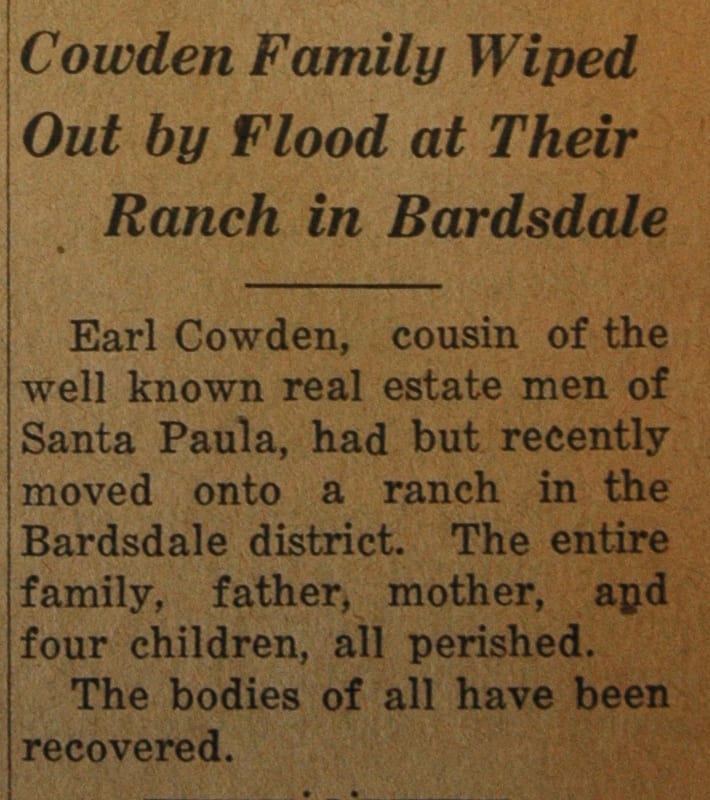
From the Fillmore American, Thursday, March 15, 1928, page 5
Local Relief Work Started Within Short Time After Alarm
The Red Cross was on the job in a remarkably short time after the report of the great disaster reached Los Angeles. Representatives of the national body at Los Angeles called the local units throughout the valley, a long before daylight the local units were functioning.
At Santa Paula, headquarters were established at the old South Grammar School on Mill street. Preparations were made to feed and care for the homeless refugees who were being rounded up. First aid supplies, and clothing were already coming in. Doctors and nurses were on hand to care for the injured who were being brought into the clinic.
At Fillmore activity along Red Cross lines were started with equal promptitude. A temporary or emergency hospital was opened at the Fillmore High School. It was located in the cafeteria, because of the facilities there for preparing hot food, and the supply of hot water so essential.
Everywhere the local doctors were on hand. Dr. Harold B. Osborn, with Robert Kieffer, of the Edison company, left Fillmore at 6:30 for the Edison camp to the east. The highway at the refinery was overflowed and a mass of dirftwood and dirt was there. They fought their way through as far as the J.M. Sharp ranch beyond Camulos. Then they had to take to their feet and the hills.
The next car through contained among others Leo A. Smith, of the Santa Paula Chronicle, and Rev. G.U. Gammon, of the Fillmore Presbyterian church. Drs. Manning and Whitlow were also called into service at the east. This left Dr. Louella Kerr as the only physician available for service at the local emergency hospital, and for a while she and the nurses were taxed to the utmost limit of their endurance.

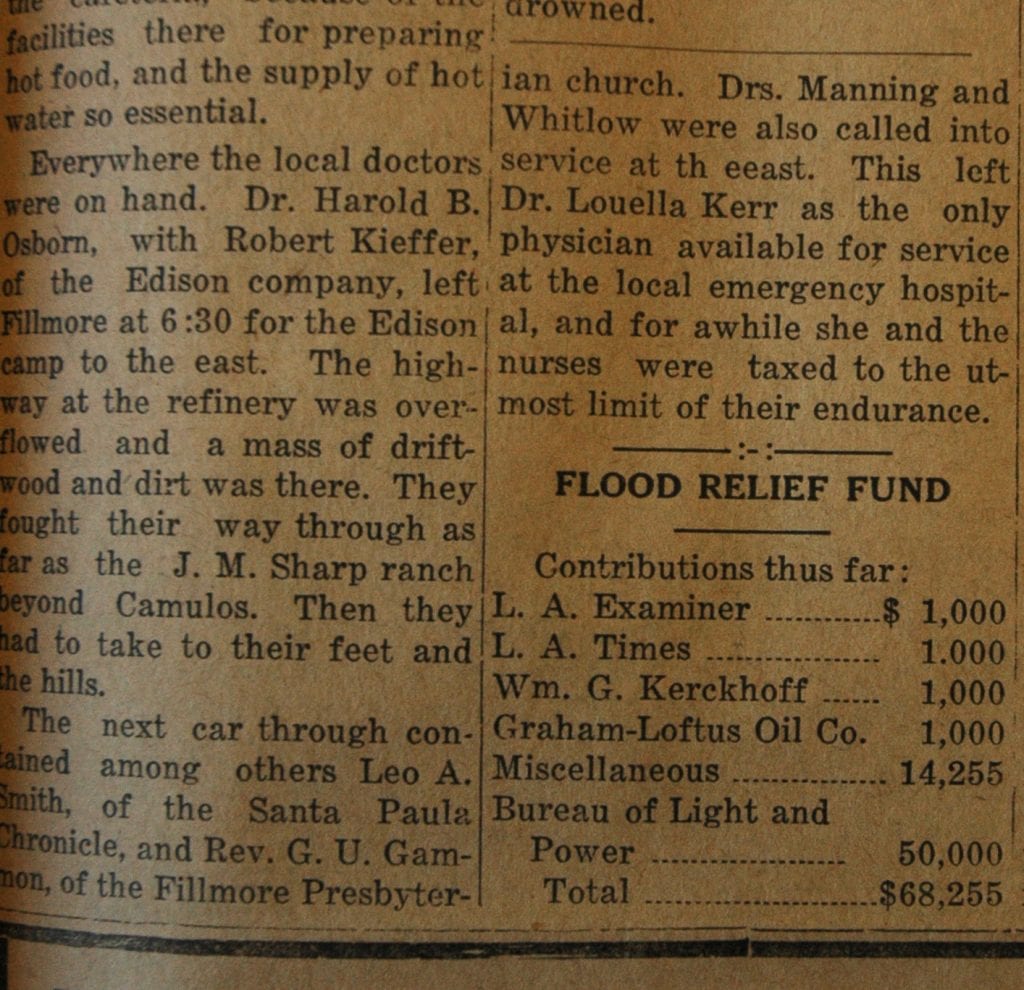
From the Fillmore American, Thursday, March 15, 1928, page 5
Santa Paula Has Named Its Survey Committee
The general committee in charge of the flood situation at Santa Paula has named the following committee to make a full survey of all losses:
I.B. Marin, Chairman; I.P. Browne, W.A. Hudson, Roy Wilson and H.H. Younken.
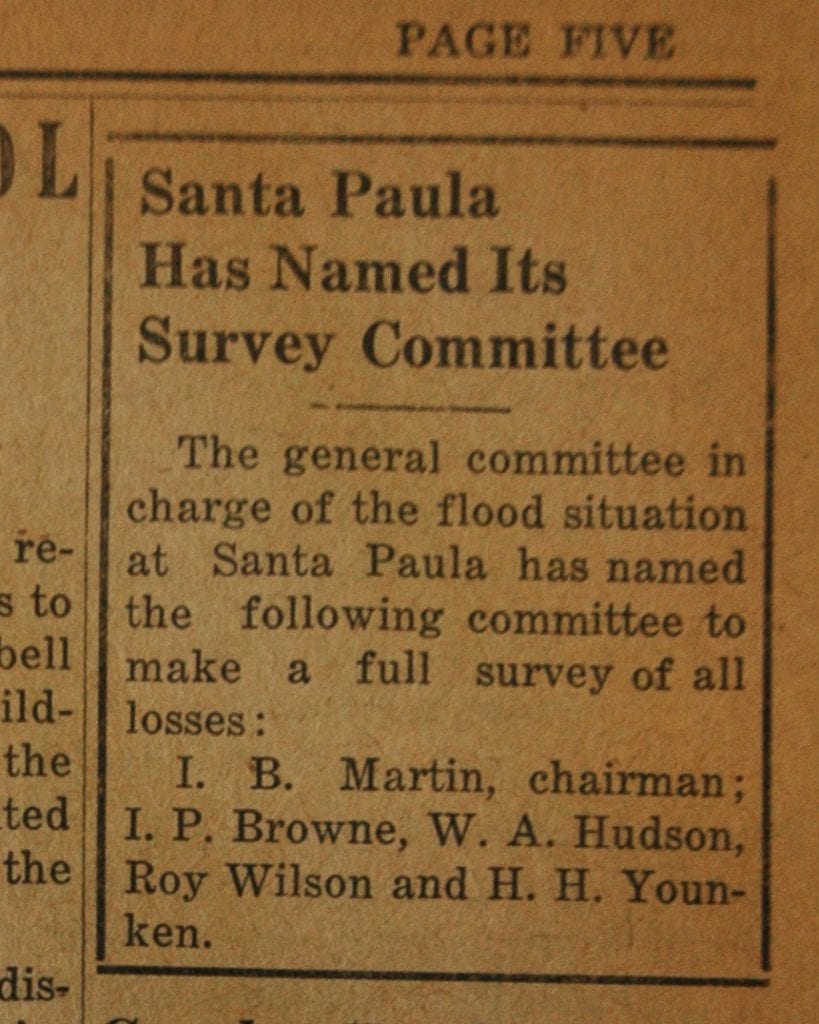
From the Fillmore American, Thursday, March 15, 1928, page 5
Says Los Angeles Will Pay Damages
Mayor Cryer of Los Angeles assumes responsibility for the damage in the following statement:
“Los Angeles cannot restore the lives lost, but the property damages should be paid. The dam was a part of the city facilities for supplying Los Angeles with water. The responsibility is ours. I do know how the money can be raised to meet these claims. That is a legal question to which are attached many technicalities. But a way must be found to pay the money for the property damage done”.

From the Fillmore American, Thursday, March 15, 1928, page 5
Toll of Death Now Stands at 500
During Thursday Morning, 44 names were added to death list; inquests being held in County
Inquests were being held Thursday throughout Ventura county at every one of the temporary morgues by Coroner Reardon. Thursday night, Deputy Sheriff Carl Wallace, head of the bureau of identification of the sheriff’s office, photographed all the dead in the morgues. It was a splendid bit of work.
The Edison company have accounted for 63 of the 148 men at its camp at Kemp. The rest are either identified as dead, or still on the missing list.
The total, which fluctuates with every partial report as tabulated, stands substantially at 200 dead and 300 on the missing list. One of these tabulation set the list of known dead, with the bodies recovered as follows:
Newhall 52 Fillmore 49 Santa Paula 51 Ventura 14 Castaic 12 Oxnard 8 Bakersfield 8 Total 193
To that table at least two should be added at Santa Paula, and two or three more at Fillmore.
Many of the dead have already been claimed by friends and taken to other places for interment.
While the above figures practically cover the situation it will probably turn out that an actual summing up of all the casualties will not be available much before the next weekly appearance of this paper.
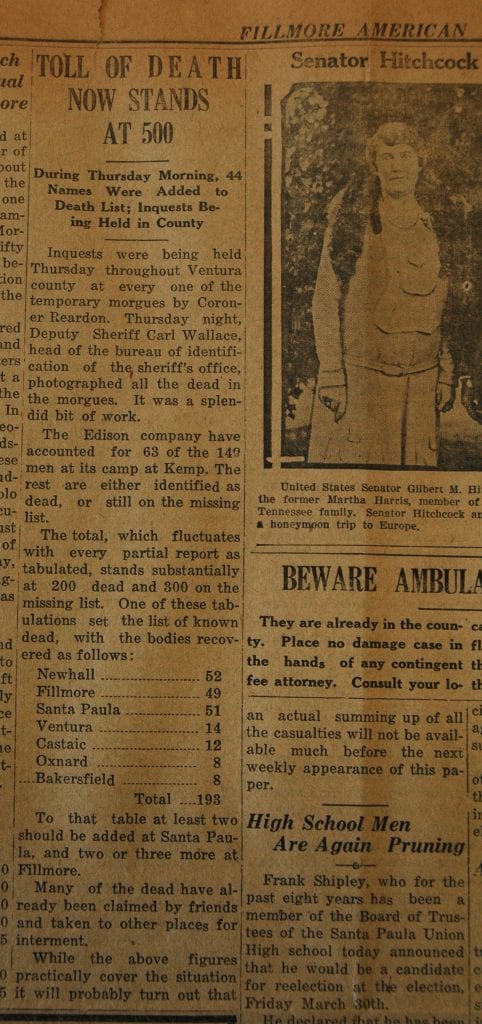
From the Fillmore American, Thursday, March 15, 1928, page 5
Water Did Not Reach Far Up Into Actual Limits of Fillmore
The water of the flood at Fillmore reached the corner of A and Ventura streets, about three or four blocks from the Bardsdale bridge. Only one house in this section was damaged, the home of James Morrison, one hundred and fifty feet south of the city limits being moved off its foundation and moved almost out onto the highway.
Hundreds of people gathered at the great intersection and followed the receding waters down until they could get a glimpse of the place where the Bardsdale Bridge had been. In this crowd were scores of people with relatives on the Bardsdale side. And many of these were well nigh frantic, including members of the Basolo family whose relatives occupied a cluster of houses just beyond the bridge. Three of these houses were swept away, and Gorge Basolo, the youngest brother of the group, was drowned.
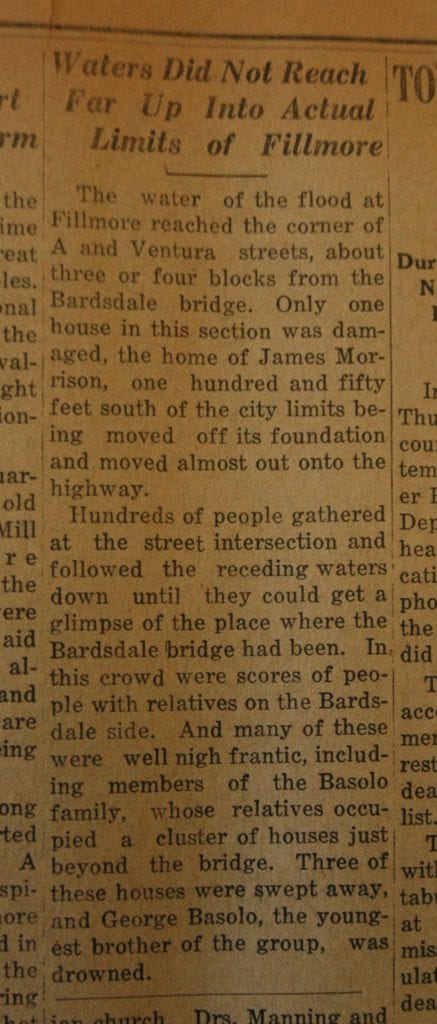
From the Fillmore American, Thursday, March 15, 1928, page 6
Relief, Rehabilitation, and then–the Reckoning
Owing to the exigencies of newspaper make-up, this is being written at a time when it is impossible to state even approximately the awful toll of life and property taken by the bursting of the San Francisquito dam of the Los Angeles water works systems. The total in both cases will be simply appalling when they are definitely arrived at.
Without hysteria, the work of restoring everything that can be restored is under way. First the relief of those who are homeless and in dire straits. Locally everywhere throughout the stricken valley this work was underway in a short time through the local Red Cross and other relief agencies.
Much was done in the almost instant creation of emergency hospitals and relief centers for caring for the immediate physical wants of hundreds of homeless refugees. Before the final section of this paper shall have gone to press, this work will have been thoroughly systematized.
Many have lost their homes with all their contents. The work of rehabilitating these people will be entrusted to such organized agencies as the Red Cross, having skilled workers trained to handle these great disasters. Nothing can restore or compensate for the lives lost. The material damages can and will be worked out. And none of the stricken sections in the valley will refuse the aid that will be promptly and systematically provided.
First aid in every way should go first of all to those who even at best are not too well provided for even under normal conditions. On the poor always falls the greatest load in such disasters.
When everything has been done that can reasonably be done to relieve immediate suffering, and to put remaining survivors back on a self-supporting basis, it will be time to make another reckoning. It should also be made REASONABLY, and RELENTLESSLY.
So far as is humanly possible Los Angeles, the most selfish and arrogant city on the Pacific coast, must be made to repay the damage caused by its greed and avarice. When this dam was underway protest after protest was made by the people of this valley and county, against the impounding by the big city of the run-off from the watersheds of this county of waters that if permitted would naturally find their way down through the Santa Clara Valley. This disaster has proved that contention, BUT AT AN AWFUL COST. And the city of Lo Angeles must be made to UNDERSTAND THAT COST AND TO PAY IT, SO FAR AS SUCH COST CAN BE PAID IN COIN.
Knowing that they were doing something that they had no right in equity to do, that municipality hastened the construction of that dam, in the face of protest and even in the face of legal injunctions.
It was built hastily, and self-evidently in a faulty manner. While this dam was in course of construction its method and design was criticized by many competent to speak in this matter. One of the greatest engineers in California who inspected the dam in its preliminary stages compared it to “a woman’s apron”.
Not in anger, but with all the resolutions of an injured people, who have lost their own flesh and blood, as well as in material things, this mighty bill must be presented to Los Angeles. And its collection must be pressed continuously until every legal means of obtaining redress has ben exhausted.
That is the program:
RELIEF, REHABILITATION, AND THEN–THE RECKONING.
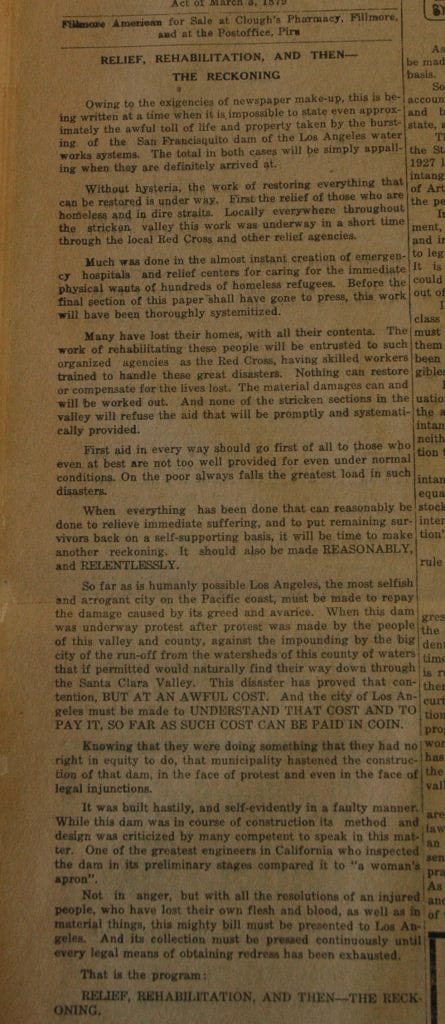
From the Fillmore American, Thursday, March 15, 1928, page 8
Miraculously Rescued From Flood, Says Pearl V. Barnard
Well known local mission worker of Santa Paula furnished this paper with this story of her escape:
“Having been in the custom of not retiring until very late, being engaged in mission work for many years, I retired Monday night a little after 11 o’clock. Had quite a nap. Woke about 2:30 a.m., according to the clock by my bed. I must have fallen into a deep sleep for I never heard voices or any alarm. And if I had heard a whistle it was what I have often heard.
I did not hear the neighbors talking. I woke quietly and as I did there was a sound as of large raindrops or soft hail on the roof. I found myself up and out of bed, but not startled in the least. Then I wondered why and how I arose. I cannot tell, it seemed as if I was lifted up. Then it sounded like great chunks of hail and thunderbolts and a great earthquake shaking the house.
I thought Santa Paula was now having a terrible storm after having had none for a long time. I threw myself on the foot of the bed for a moment and then putting my bare feet on the floor felt shallow water. I calmly stepped to my bed room door and unfastened the screen door and stepped out to escape. As I stepped out I heard things swirling inside. When I got out I was gripped by the flood and whirled around like a ball.
My mouth filled with water and debris and I was gasping for breath. As I came up, I clasped my hands and looked up and said: Oh, God, I am drowning. I do not want to lose my faith in Thee, and I want to die a Christian.
Just then there was coming at me whirling things, cracking and snapping, and there seemed to be a gleam of light, enough to show me, so I stretched out both hands and grabbed, for something, I did not know what. After this I seemed to sit down on something and some object ran into my lap. Thinking it was a cat, I slung it out, and as I did I found it to be a little white chicken, I did not see it again.
But one chicken stayed by my side all night. I felt that I was drifting down the river and sooner or later would reach the ocean. I sat quietly on rather a sharp edged beam. With my night gown on an my wrist watch. I was holding on with my hands on either side, and braced with my left foot until about five o’clock in the morning. I prayed, and and the more I prayed, the less chilly I felt. I was just recovering from a bad cold, and hoped it would not have a bad effect on me.
I wondered how all my dear neighbors were, and thought of my loved ones and friends, but most of all, of Daniel’s God who could deliver, and felt that somehow I was safe. And would be rescued some way. As daylight was breaking I felt the water subsiding, and wondered how near land I was. I discovered I was on the side of an old barn. And I was not in the middle of the river, but up against a big tree not far from Harvard boulevard on the south side. And here was where I had been all the time, and not floating as I thought I was.
I looked over at day break and saw houses on my left and soon heard voices. I was thankful. I saw five people, and as they came close enough I called several times before they heard me. I asked them if they could help em, and two young Mexican boys came and rescued me. They took me a few steps north up Harvard boulevard, and an auto just in front of us in which was Guy Bagley. The boys asked him to take me up town. He took me up to the old Cottage Hospital building, and no one being there, I said: “Oh, there is Mrs. Merrill’s home. She will take care of me.”
Mrs. Merrill rushed me upstairs to the bath tub. Then I went to bed, and stayed there until about 2:30 p.m. It then several hours before my body got warm. Mrs. O. O. Keller came to call on me in the forenoon, several more in the afternoon, among them my pastor, Mr. Stranberg. My friends will want to know how I am. My throat is a little sore, my limb somewhat bruised, a few slight scratches, but not at all serious. Frinds have been very kind and thoughtful, especially Mrs. Merrill, Mrs. Frank Schulze and Mrs. Price, and Dr. and Mrs. Crawford, who have given me a home. I am really very well.
I extend great gratitude to the boys who rescued me, and want all the Santa Paula people to know that they have a warm friend indeed in me.”
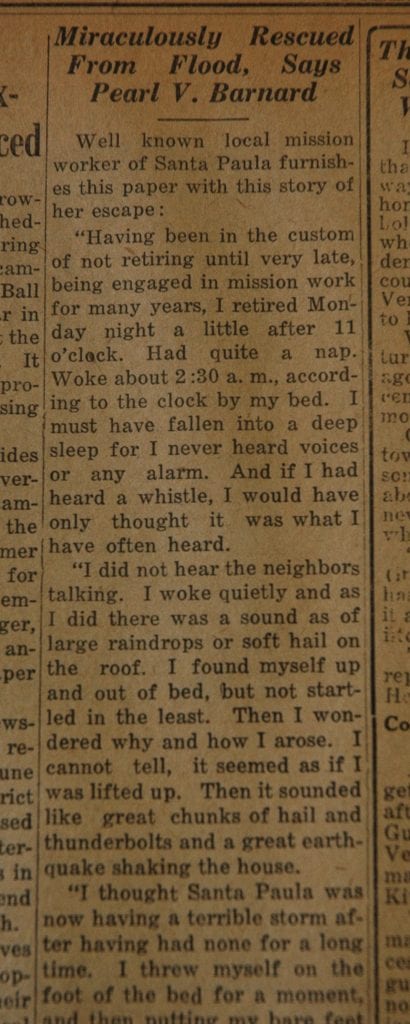
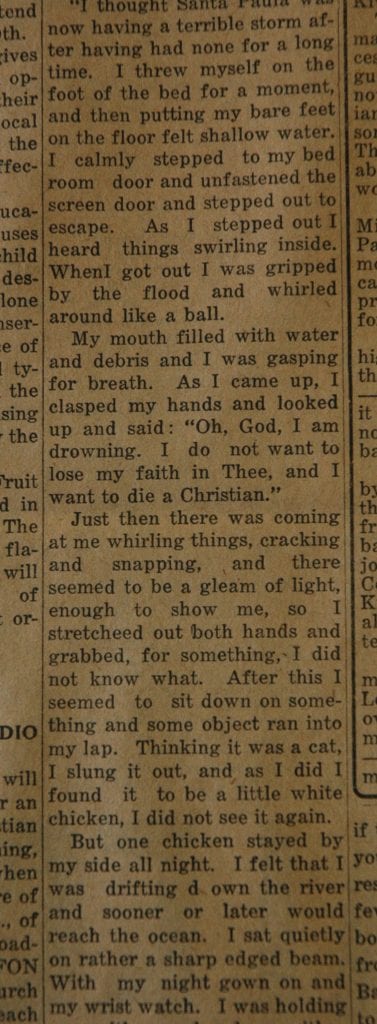
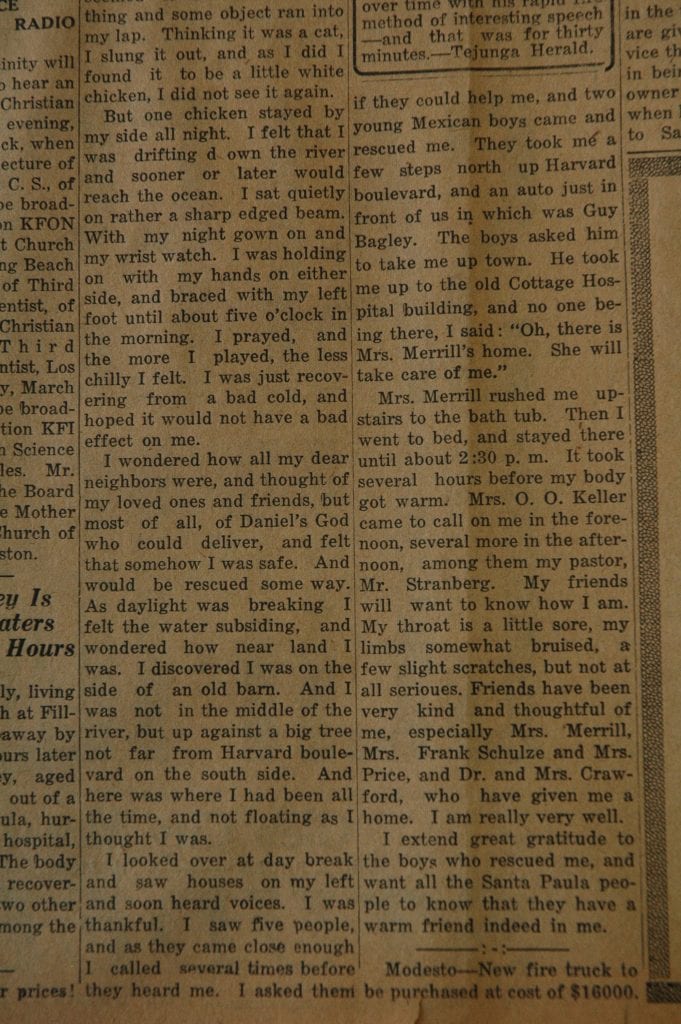
From the Fillmore American, Thursday, March 15, 1928, page 8
Thelma McCauley is Taken from Waters After Twelve Hours
The McCauley family, living on the Chadsey ranch at Fillmore, were all swept away by the flood. Twelve hours later little Thelma McCauley, aged thirteen, was taken out of a drift pile at Santa Paula, hurried to the temporary hospital, and may yet recover. The body of her father has been recovered. Her mother and two other children are still among the missing.
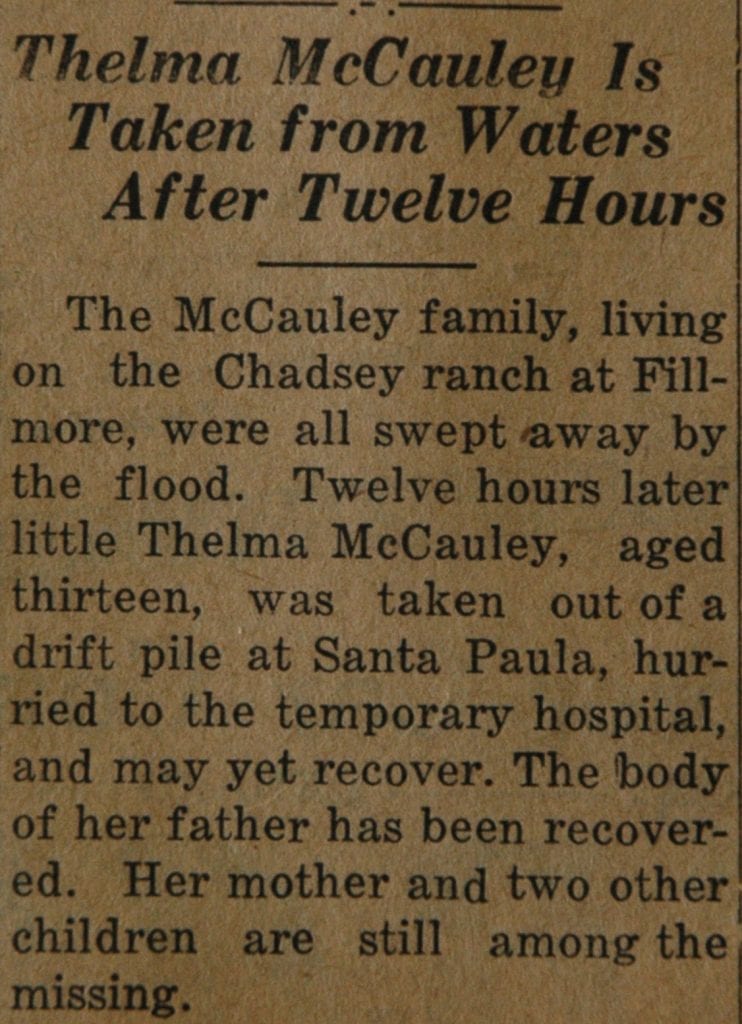
From the Fillmore American, Thursday, March 22, 1928, page 1
City of Los Angeles and Nat’l Red Cross in General Charge of Relief and Rehabilitation Now
General Relief Work Supervised by Red Cross, Other Organizations Also Doing Splendid Work; Los Angeles Bureau of Light and Power in Charge of Clean-up and Restoration
Since the first alarm of the great flood came Tuesday morning of last week, the picture here in the flooded district has changed every minute. But there was a steady progress towards centralization and organized control of the situation. Most of this centered around the offer of the City of Los Angeles to immediately provide $1,000,000. This was officially done last Monday morning.
From four separate agencies, funds for the restoration and relief of the flood area are being expended in a systematic manner to revive the prosperity of the Santa Clara valley before the breaking of the St. Francis dam. Alexander Heron, governor’s representative, told the board of claims and inquiry set up by the board of supervisors for the county.
The largest of these funds, which consists of the million already appropriated by Los Angeles city council and will total many millions more before restoration is completed is to be used to place the homeless in a condition of help themselves and later, to repair the damage done to lands along the river’s edge.
The second of these, is the money being expended by the Los Angeles engineering corps in sending 1500 to 2000 workmen with elaborate equipment that now totals 123 tractors, a large number of steam shovels and movable cranes, to tear apart the debris from one end of the flood area to the other.
The third is the emergency contributions coming from relief theatricals, newspaper funds, personal contributions and so on that is being turned over to the American Red Cross to supply emergency relief in the form of food, clothing, and shelter to the 1200 persons made homeless by the flood.
Trust funds are being established for orphaned children from these funds, while everything is being done to prevent an after effect of the flood from taking additional lives through disease or want. J. W. Richardson, a native of Santa Paula, and director in the Red Cross, is in charge of the work.
The fourth fund, is the national fund of the Red Cross, which is being used to pay the expenses of keeping the officials of the Red Cross in the territory and is paying the expenses of the staff workers in the area.
A new committee which will co-operate with the Red Cross officials at Santa Paula, with the citizens committees of Los Angeles and with the Los Angeles engineers, was appointed a conference between Charles Petit, C. C. Teague and Alexander Heron on Tuesday.
The members of the committee are:
C. C. Teague, chairman, will represent Santa Paula; John McNab, Fillmore district; Richard Bard, Oxnard district from Montalvo to the Pacific ocean; James Walter, Piru district; Roger Edwards, Saticoy district; George N. King, Bardsdale district and Arthur Cheseborough, Newhall relief.
The committee will be in daily session with the heads of the relief work and will be the contact agency between the ranchers injured by the flood and the agencies in Los Angeles that are handling the restoration work.
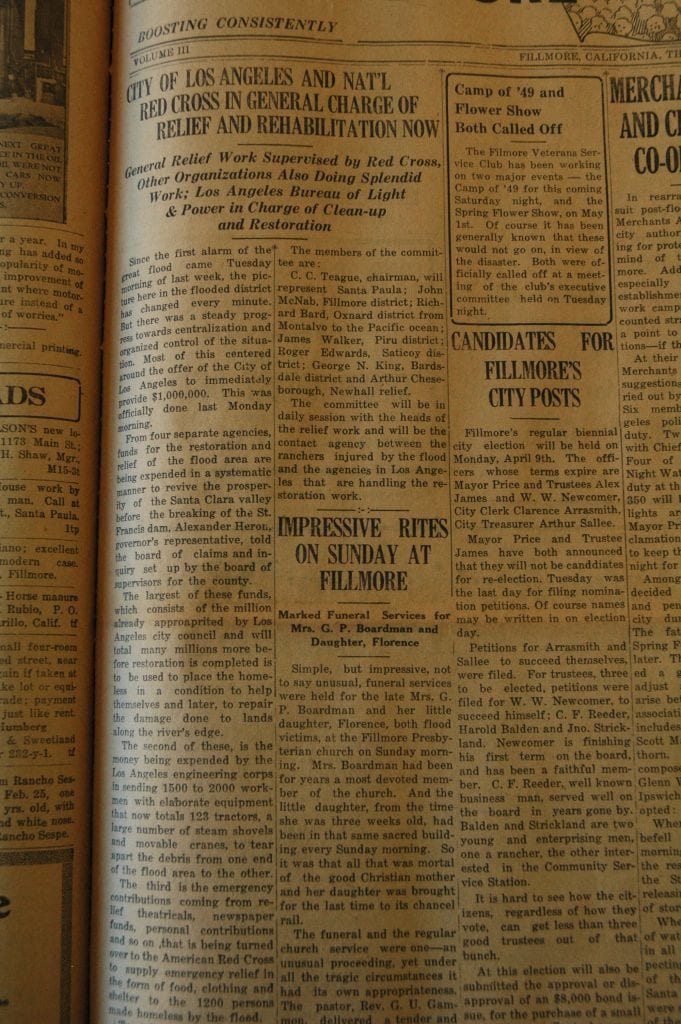
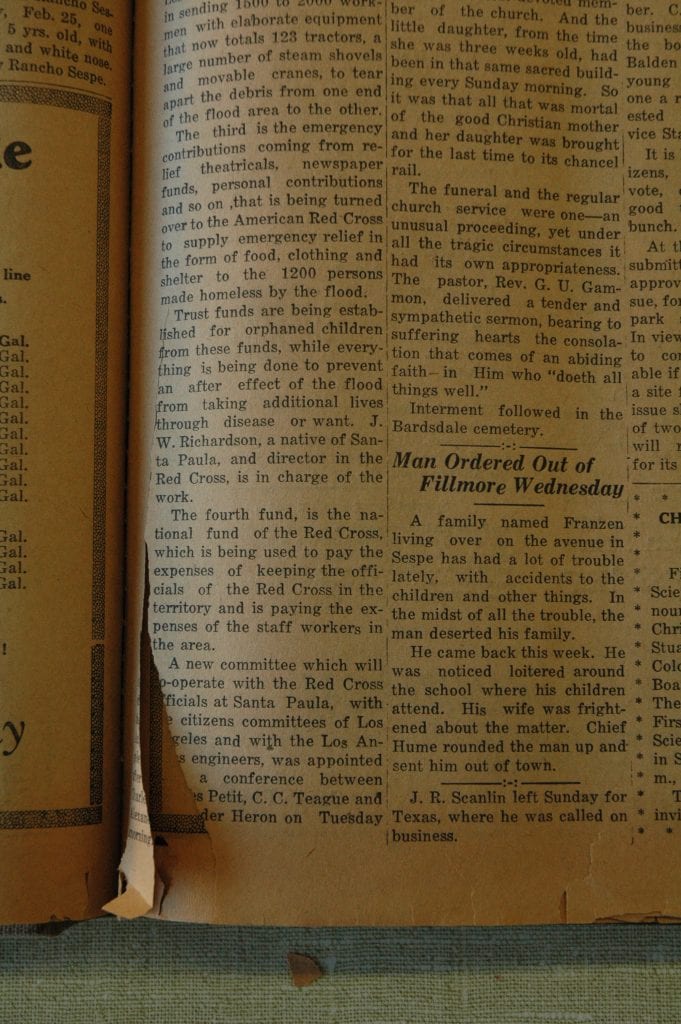
From the Fillmore American, Thursday, March 22, 1928, page 1
Fillmore Club of Veterans Did Fine Work
Have Closed Their Field Headquarters, and Are Busy Checking Up in Order to Turn Records Over to Red Cross
The Fillmore Veterans’ Service Club, as an organization has turned over its activities to the central authorities now in charge. As individuals, however, everyone of them is still busy. They were prompt to get to work on the morning of the disaster. They worked continuously and efficiently until the time came to merge their work with the central organizations taking over the work. To name all of the members of their organization that gave unstintedly of their time and energy it would be necessary to print the club roster of more than 120 names.
Their records of expenditures for supplies and labor are being carefully tabulated in order that they may be turned over to the Red Cross for settlement. They did a splendid work, did it unselfishly and unflinchingly. Their headquarters in the Opsahl building has been closed. Miss Pauline Irwin, the stenographer, has gone to the office of the citizens committee, headed by E. O. Goodenough, which was its office on Main street, in the rear room of the Bank of Italy building. The work of this committee will be almost entirely in co-operation with the other local and citizens committees in the county that are engaged in checking up the claims and losses. Chas. Jarrett, of the club, is employed looking after labor matters at the camp of the Burearu of Light and Power, which has been set up on east Santa Clara street, near the Standard Oil depot. The secretary of the Club, Kenneth Oliver, has been loaned by the Ranch Sespe for a sufficient time to check over the records of the club for the Red Cross.

From the Fillmore American, Thursday, March 22, 1928, page 1
Impressive Rites of Sunday at Fillmore
Marked Funeral Service for Mrs. G. P. Boardman and Daughter, Florence
Simple, but impressive, not to say unusual, funeral services were held for the late Mrs. G. P. Boardman and her little daughter, Florence, both flood victims, at the Fillmore Presbyterian church on Sunday morning. Mrs. Boardman had been for years a most devoted member of the church. And the little daughter, from the time she was three weeks old, had been in that same sacred building every Sunday morning. So it was that all that wa mortal of the good Christian mother and her daughter was brought for the last time to its chancel rail.
The funeral and the regular church service were one-an unusual proceeding, yet under all the tragic circumstances it had its own appropriateness. The pastor, Rev. G. U. Gammon, delivered a tender and sympathetic sermon, bearing to suffering hearts the consolation that comes of an abiding faith – in Him who “doeth all things well.”
Interment followed in the Bardsdale cemetery.
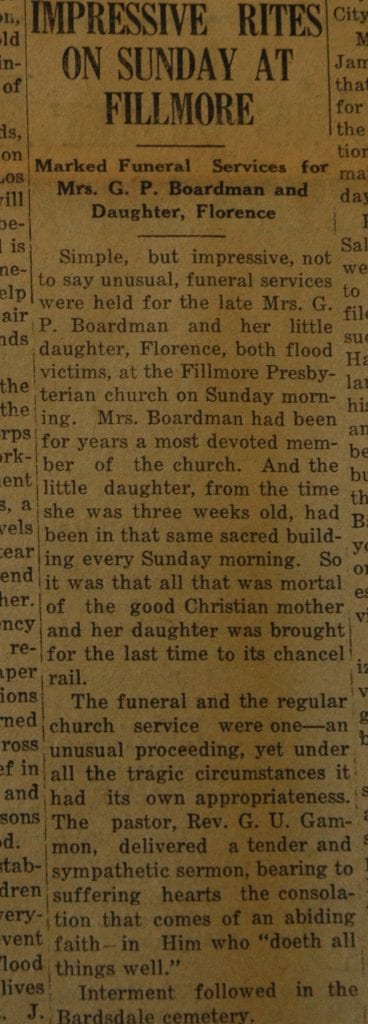
From the Fillmore American, Thursday, March 22, 1928, page 1 and 5
List of Known Dead Found in Ventura County, Together with Numbers of Unidentified
In the Case of Those Unidentified Complete Descriptions Are on File, Together with Photographs in Many Instances; Every Care Being Taken to Make Identification Easy
Following is the list of the known dead and identified in Ventura county, for which we are indebted to Milton Teague, of Santa Paula, who has made and corrected the lists as reported from the various points in the county. Where bodies have not been identified at this time, they have been numbered and every precaution taken to facilitate their identification later on:
Bodies Brought to Morgue in Fillmore
- Mary Ruiz
- Norma Coe
- Mrs. Harry Burns
- C.L. Wolfe
- Teviano Monorez
- Thos. Shea (first identified as Keith Anderson of Edison Co.)
- Unidentified male
- Susie Ruiz
- Barbara Hughes
- Myron Dale Fuins
- Maria Martinez
- Juliano Alvarez
- C.W. Harter
- John Barry
- Leon Haley
- P. Rivera
- Burt L. Jones
- Geo. L. Lagerman
- Timothy Andrews
- J.R. Isaacs
- Carl J. Mathews
- Harry Mathis
- A.J. Kingston
- C.M. Anderson
- Nick Nodlock
- J.H. Bryson
- Oscar Jim Doty
- O.R. Westbrook
- Paul Massette
- Edward Locke
- O.T. Leadbetter
- Mr. Peterson
- Mrs. Wm. Topley
- Doris Rogers
- Richard Rogers
- Chester Rogers
- Margaret Rogers
- Sonomo Carrillo
- Richard Gottardi
- Lee Cowden
- Mrs. Steve Zavala
- Mrs. Joe Martinez
- Mrs. Jesus Carrillo
- Mrs. Kaffer
- Mrs. Fred Zavala
- A.J. Guertler
- Frank Bianchi
- Mrs. Earl Imus
- Jerry Kimball
- Cowden child
- Alvarez boy
- Florence Boardman
- Jack Ely
- M. Muyachi
- Morris Elliott
- Leandro Velazques
- Unidentified Mexican Woman
- Mrs. Bessie McCarthy
- Harley Berry
- Jose Zavala, 6 mo. old
- Unidentified
Bodies Brought to Morgue in Fillmore
- Mat Costamagna
- Any Wilson (O.A. Hylton, real name)
- A.V. Chesney
- J.P. Hungerford
- Milford McCauley
- Unidentified
- Jose Carrillo
- Elvira Luna
- Esther Luna
- Lupe Luna
- Henry Luna
- Inez Alvarado
- “Whitey” McLain
- Unidentified
- Ray Dyment
- Martin Ruiz
- Ed Crumley
- L.C. Robertson
- Fred Tayor
- Unidentified
- Walter Clburn
- Grace Stephens
- Earl Kerr
- Alberto Rivera
- S.G. Grantham
- Rex Johnson
- Joe Martinex
- Unidentified
- Unidentified
- Jessie Perez
- Marian O. Harter
- Ida Maria Parker
- Antonio Perez
- Sara Whitehead
- Minnie Frazer
- Matilde Samaniego
- Van Wallace Duke
- E. Bilyen
- P deArcy
- Joseph McIntyre
- Edward Vickroy
- Geo. Ludloff
- Andrew Lawson
- Maria Torres
- Mercer TOrres
- Philip Casena
- Unidentified
- Duplicate of No. 41
- Raymond Ruiz
- C.E. Alierson (Alliason)
- Hipolito Serna
- A.C. McIntyre
- Andres Gutierrez
- Unidentified man (American
- Ramon Alvarez (Fillmore No. 51)
- Maria Bravo Perez
Bodies Brought to Morgue in Oxnard
- Margaret Cowden
- Mrs. Grace R. Boardman
- M. Meyagi
- Tony Capello
- Wm. Dee Cowden
- Jackim Kiemann
- Earl Cowden (same as No. 6 Moorpark)
- Joe Gottardi
- Reno Gottardi
- George Basolo
- Unidentified American man about 40
- Unidentified American man about 60
- Unidentified American baby girl about 6
Bodies Brought to Morgue in Moorpark
- Mrs. Grace Boardman (No. 2 at Oxnard)
- Phillys Kelly
- Dolores Kelly
- Mrs. Ida Kelly
- Harold Kelly
- Earl Cowden
- Gordon Cummings
- Jeff Hunich
- Inez Hewitt Kern
- Mavis Cummings
- Geo. Basolo (No. 10 at Oxnard)
- Raymond I. Kearn
- Mrs. D. Stephens
- Ferrell Hopp
- Charles E. McCarty
- Ellen Cresno
Bodies Brought to Morgue in Ventura Morgue (Reardon’s)
- Adolph Camillo
- Melvin Frazer
- R. W. Wilson
- Unidentified Man about 60 – bald and stooped shouldered
- Lester Van Meter
- Henry Ruiz
- Mr. de Shields
- Kenneth Halen
- Monroe K. Richardson
- Roie Martinez
- Isabel Torres
- Mary C. Holt
- Jose Martinez
Bodies Brought to Morgue in Ventura Morgue (Baker’s)
- Sartana Samaniego
- W.R. George
- Frank Porter
- Unidentified American about 35
- Unidentified American baby about 9 months
- Rose Zavala
List of Persons Reported As Missing at Newhall
- Jessie L. Asher
- John Bedel
- Paul J. Best
- Beryl Bogue
- Pearl Casper
- Peter Costa
- J. A. De Costa
- Margie Curtis
- Aaron Ely
- Mrs. Appie Ewing
- Julian Goldman
- Paul Gregson
- Coder Harnischfeger
- Tony Harnishchfeder
- Otto Heinrich
- Holzlaw (baby boy 6 months old)
- Farrel Hopp
- F.R. Howe
- Florence Issacs
- Norman Issacs,
- Isam (male, probably middle age)
- Mrs. Bert Jones
- Lucy E. Jones
- Tom Kennedy
- Ross Ledbetter
- Martinez (baby 1 1/2 years)
- Mary Martinez
- Stover Martinez
- Dorothy Mathis
- Helen Neilson
- Jessie B. Rice
- Eddie Ritchie
- Mrs. J.L. Sauder
- Harry Sewell
- Cecilia M. Small
- Felda or Pike Smith,
- Smithwick (man)
- Wm. Thomas
- Howard Thompson
- Lloyd W. Weinland
- Mrs. L.W. Weinland
- Chas. Wilson.
List of Persons Reported As Missing at Santa Paula
- Corrine Cowden, aged 28
- Betty Cowden, age 7 months
- Mrs. Louise Burns
- Burns Boy, 11 years of age
- Fred Burnett
- William Davis
- Roy Ely, age 4 years
- Lorenzo Flores
- William Fry, age 28
- Harold Frame
- Leslie Frame
- Vernon Frame
- Angel Garcia, age 40
- Delfina Gottardi, age 5
- Pauline Gottardi, age 7
- Francisca Gottardi
- C.M. Halen, age 52
- F.R. Howe, age 26
- Nettie Hughes, age 32
- Raymond Imus
- Waldo P. Janeway, age 22
- M.T. Kampman, age 35
- Joe Knight
- Jess T. Kyle, age 30
- Consuelo Luna, age 7 years
- Mr. Mendellson, age 70
- Mucci
- Francisco Ochoa
- Guadalupe Padilla, age 26
- Genaro Peres
- Rose Peterson, age 19
- Primenio Reyes, age 29
- John “Shorty” Rodriguez, 25
- Elisa Rodriguez, age 24
- Charles Schmidt, age 59
- Harry Sewell
- Mrs. Schaeffer, age 35
- Shaeffer girl, age 6
- Dave Stephens, age 50
- I.W. Swanger, age 21
- Addie Truesdale, age 6
- Jose Velasquez, age 35
- Juanita Velaquez, age 28 and 5 children
- Joe Weir, age 35
- Mrs. Forrester
- Cocer Harischfeger, age 6
- Anthony Harnischfeger, age 42
- George Trogeler, age 30
- Ormon Page, age 24
- Ysidro Gonzales, 56 years
- Luz Gonzales, age 54 years
- Carlos and Emilia Gonzales and 5 children (between 6 and 20 yrs of age)

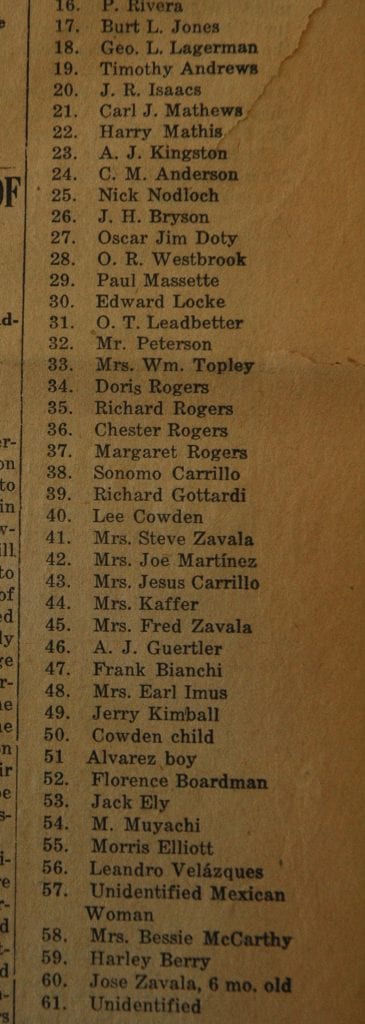
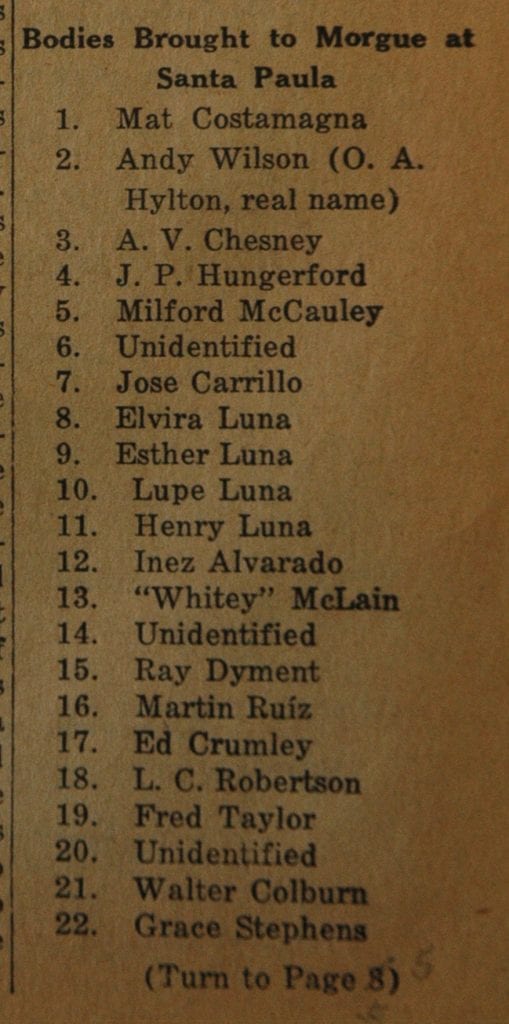
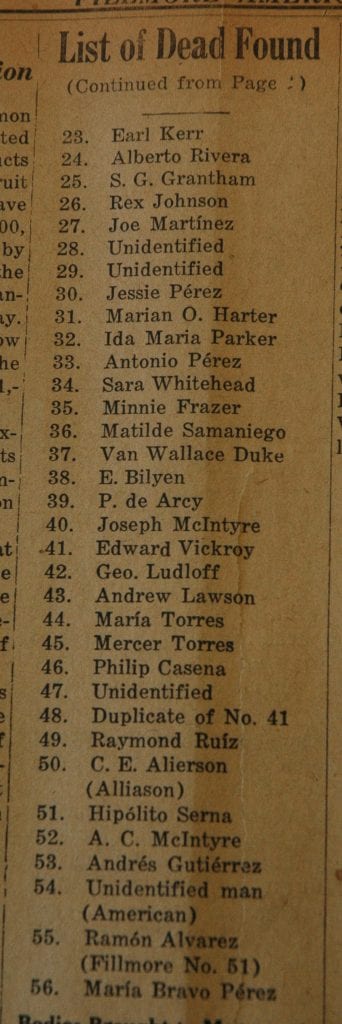
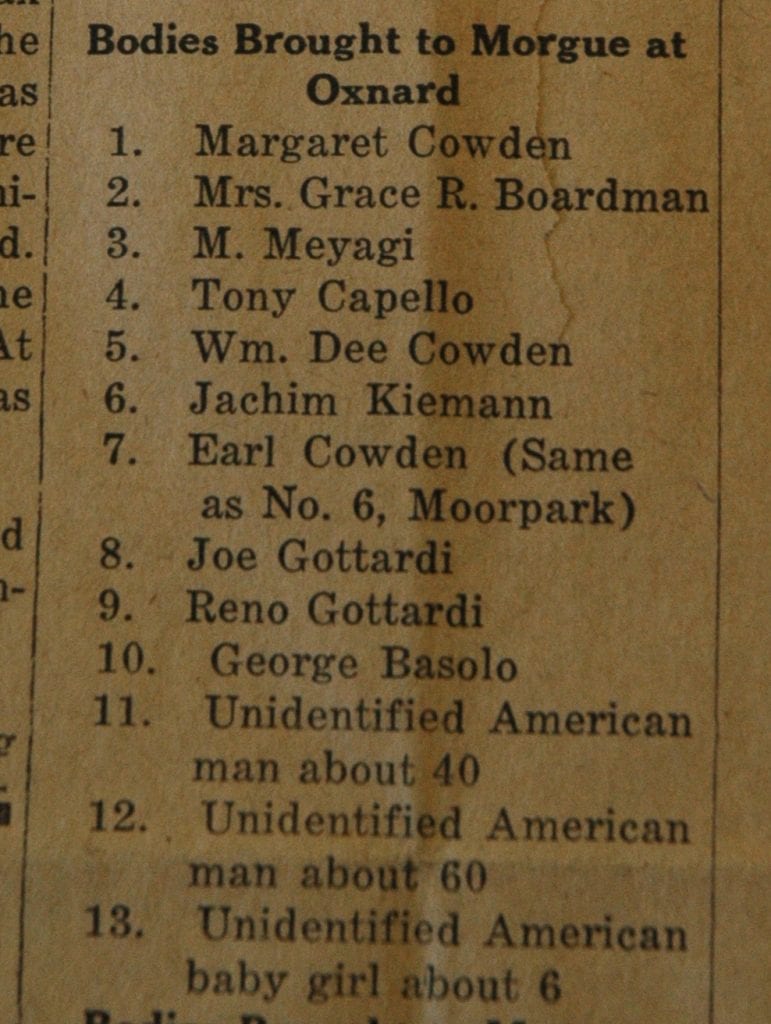

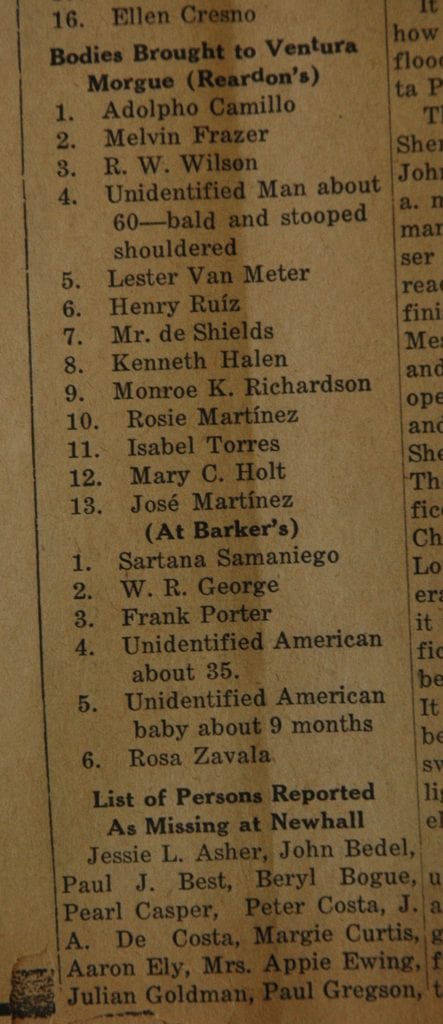


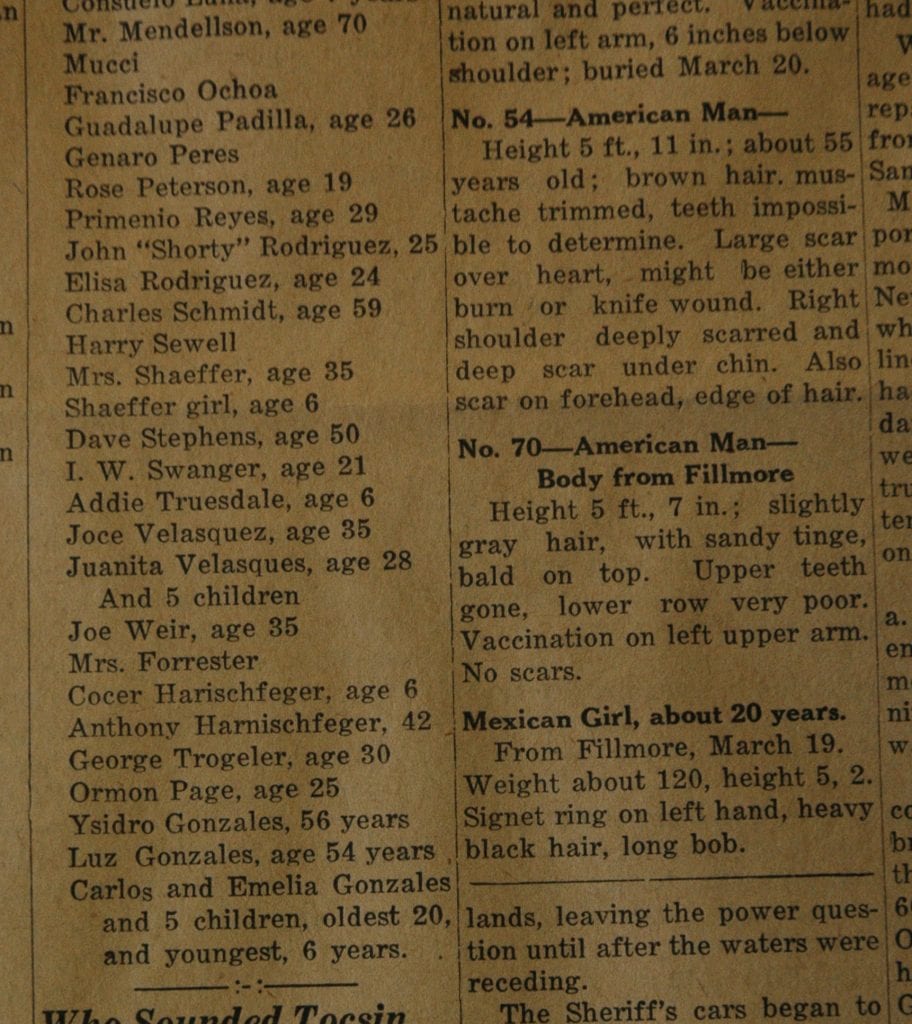
From the Fillmore American, Thursday, March 22, 1928, page 1 and 8
Merchants Asn. and City Dads Co-Operate
In rearranging matters to suit post-flood conditions, the Merchants Association and the city authorities are co-operating for protection and peace of mind of the citizens of Fillmore. Additional protection, especially at night, since the establishment of reclamation work camps. Besides the uncounted strangers who make it a point to slip into such sections – if they can.
At their last meeting, the Merchants Association made suggestions that have been carries out by the city authorities. Six members of the Los Angeles police force are doing duty. Two in the day time — with Chief Hume also on duty. Four of them at night, with Night Watchman Howard on duty at the city hall. A call to 350 will bring him. The city lights are to burn all night. Mayor Price has issued a proclamation requesting residents to keep their porch lights on at night for the present.
Among other things it was decided to keep all carnivals and penny affairs out of the city during this emergency. The fate of the Merchants Spring Festival will be decided to keep all carnivals and penny affairs out of the city during this emergency. The fate of the Merchants Spring Festival will be decided later. The association appointed a good will committee to adjust any friction that may arise between members of the association. The committee includes N.J. Lindenfeld, W. Scott Massey and C.W. Harthorn, Glenn W. Harmonson and Jas. Ipswich, were unanimously adopted:
Whereas: A great calamity befell this community on the morning of March 13, 1928 as the result of the breaking of the St. Francis dam, and the releasing of n immense body of stored water, and
Whereas: This great flood of water so released descended in all its fury upon the unsuspecting and defenseless people of this community, and the Santa Clara Valley, while they were slumbering in the security of their respective homes, leaving in its wage an appalling loss of life, disaster and desolation, and
Whereas: The enormity of this catastrophe, and the necessity of relief an of action, sure and effective, became immediately apparent, there arose out of our citizenry a body of men who accepted the responsibility and without hesitation, instituted and rendered to this community its sufferers and its victims, and unselfish service, performing a self-imposed duty that was and will be the admiration of our people for all time, therefore, be it
Resolved: That That the business interests of Fillmore Community extend to the Veterans Service Club, its leader, R.A. Fremlin, the lieutenants, the committees, and the various committees, who gave without stint of their time and energy in the hour of necessity, our deep, sincere and lasting appreciation and the assurance that their services have created an impression which is an inspiration to our people and an example of worthy of emulation, and be it further
Resolved: That these resolutions be spread upon the minutes of this Association and a copy furnished to the newspapers for publication.



From the Fillmore American, Thursday, March 22, 1928, page 1
Proclamation
Owing to unsettled conditions, due to the great flood disaster, citizens are urged to leave porch lights burning during the night hours. Many strange people will be in the city for an indefinite time, and every precaution should be taken. Street lights will burn all night until this crisis is over.
W.H. Price, Mayor
From the Fillmore American, Thursday, March 22, 1928, page 2
The following precautions should be observed in the flooded area until further notice was announced Saturday at the general health headquarters under the direction of D. J.A. King by M.A. Heinzman, County Sanitary and Milk Inspector:
- Pending a check up on the wells and springs, all water should boiled.
- People using milk from individual cows effected in this area should boil milk before using.
- All people working in the flooded area should take extreme precaution in washing hands before handling food of any kind.
- Typhoid immunization is being carried out at the following points: Piru, Fillmore, Santa Paula, Saticoy and Moorpark. Residents from Bardsdale should go to Moorpark as soon as possible and be immunized. All people that have been doing relief work in the flooded area should take this treatment immediately.
- Anyone knowing of people sick that might develop into an infectious disease should notify the Health Department, Telephone Santa Paula 286 or notify Dr. King at Ojai, phone 25.
County and State Health Departments general headquarters, located at South Mill street, Santa Paula, will be maintained at the general relief headquarters at Santa Paula.

From the Fillmore American, Thursday, March 22, 1928, page 2
Flood Misses Town of Piru Nearly a Mile
The flood waters, as they came down the Santa Clara river bed, missed the town of Piru by about a mile and surged past with but a very few people being aware of the deadly deluge. The highway to the east, for several miles, was swept away and the Edison camp site was swept off the earth. Farther east the Castaic Junction buildings were entirely swept away.
While the Camulos Ranch was the victim of property loss to the extent of hundreds of thousands of dollars. There was no loss of life. Mr. Rubel threw his entire resources open to the feeding, clothing and care of the refugees of the Edison camp, as well as his entire force of workmen to help in the rescue work as soon as the alarm was sounded–long before daylight–before relief of any kind from other sources arrived. Much suffering was saved the poor boys from the camp, as they were brought to the ranch, shivering with cold, naked and bleeding from the awful experience with the floating debris. Everything humanly possible was lovingly done for the unfortunate ones and too much cannot be said of the whole-hearted way in which Mr. and Mrs. Rubel entered into the relief work.
All Fillmore schools, high and grammar, are again in operation this week, the roads having been cleared to permit the busses to run everywhere.
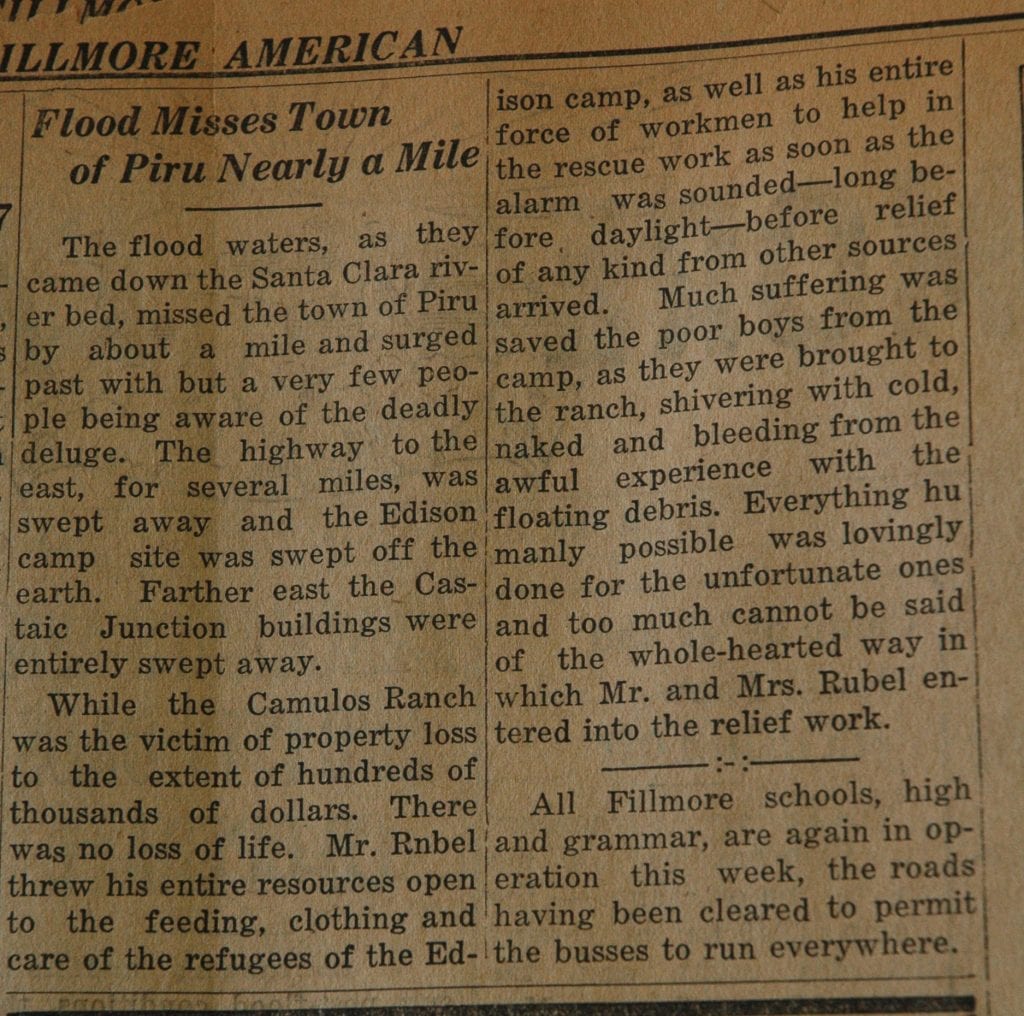
From the Fillmore American, Thursday, March 22, 1928, page 2
To the Farmers of the Flood District:
We Offer the Use of Our Trucks, Tractors and Men
GRATIS
To Help You in Any Way Possible
Jones & Dodds 138 N. 11th Street Phone 466 Santa Paula
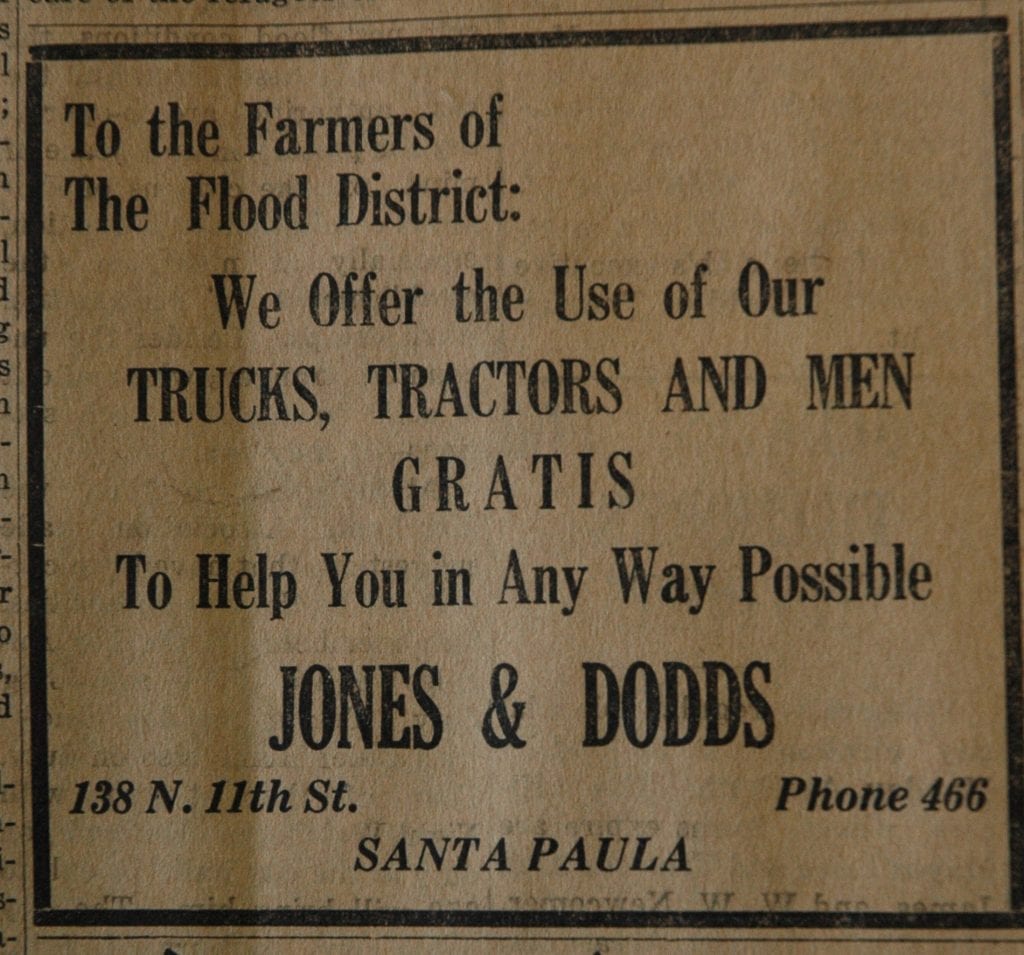
From the Fillmore American, Thursday, March 22, 1928, page 2
A Serious Week is Past (Contributed)
The week just past is the most tragic in the history of every town in this valley. Piru, however, has been been so unfortunate as have some of the other communities, her loss of life having been confined to six families.
When the various funeral services were arranged for it was discovered that there was a scarcity of flowers. Fred Chivvis graciously volunteered to make a trip to Los Angeles in order to secure from interested friends some floral contributions. Equipped with an officer’s star and a letter of introduction he started on Friday morning for the city. Because of the limited time for making arrangements, Mr. Chivvis decided to present his request to Radio KNX, and the message was broadcast on Friday evening. The response was immediate and liberal, approximately four truck-loads of flowers being promptly delivered at the radio station, and from there to Piru from distribution. Mr. and Mrs. David Felsenthal were also present to witness the eagerness with which the sympathizers seized the opportunity of doing something toward comforting the bereaved ones.
In recognition of the kindness and sympathetic interest manifested by the many donors, the following message was dispatched to Radio KNX, and broadcast by them on Friday evening:
“In behalf of the bereaved families of Piru and the valley we request that you kindly communicate to the multitudes of sympathizers our deepest gratitude for their generous floral contributions, and our appreciation to the management of Radio KNX for their splendid courtesy which made these gifts possible.”

From the Fillmore American, Thursday, March 22, 1928, page 3
Funeral Services are Held for Piru Victims
Savala Family Funeral Held on Sunday and Gottardi Family was Buried on Monday
Funeral services for Mrs. O. M. Topley, Doris Rogers, Margaret June Rogers, Chester Rogers Jr., and Richard Rogers, five of the flood victims, were held Saturday afternoon at two o’clock from the Community Church.
The funeral service for the Rogers family and Mrs. Topley was the first of the series conducted for the flood relief victims in Piru and the adjoining community. Rev. and Mrs. Coate were in charge of the service, and were assisted by Rev. Thistlethwaite, a former pastor of the Community Church, and now residing here. On Sunday evening, a special Memorial Service was held in behalf of the Southern California Edison men, who camp just east of Piru was an easy prey to the swirling waters. At this service Dr. Thistlethwaite spoke a fine audience, including a number of Edison men, survivors of the flood, one of whom voiced briefly and appropriately the appreciation of the group for this courtesy. At both of these services special music was provided by Mrs. James Walker and her Community Choir.
The grief-stricken parents have the heartfelt sympathy of the entire community in their most terrible bereavement.
Services for the Salava family
Services for the Savala family, victims of the flood, were held at San Salvador Church, Sunday, March 18, at 5 o’clock p.m.
The family of Stephen L. de Savala, consisting of eleven members, of whom only four survive, four are still missing and the three members for whom the services were held were Mrs. Carlota L. de Salava, aged 24 years; Mrs. Enugusta L. de Savala, aged 23 years, and Rosita, aged 4 years.
The bereaved members surviving this once happy family have the sincere sympathy of the community in their sudden sad affliction.
Services for the Gottardi Family
Funeral services for the flood victims from the Gottardi family were held from the San Salvador Church at Piru, Monday, March 19. Requiem Mass was held at 10 a.m., Rev. O. Sansol, officiating.
Of this family of eleven, only two survive, Joe Gottardi, the father, and Vena Gottardi, daughter, 15 years old. Those recovered and for whom the services were held were Reno Gottardi, aged 14 years; Joe Gottardi, Jr., aged 11 years; and Richard Gottardi, aged 7 years. Those still missing are Mrs. Joe Gottardi, mother, and five children.
The sorrowing father and lonely daughter have the heartfelt sympathy of the whole community in their terrible loss.

From the Fillmore American, Thursday, March 22, 1928, page 4
Flotsam and Jetsam
Here is a suggestion where any one with time on their hands and a little money, can do a very great good. It comes from an Auxiliary member: Packages containing black and white thread, assorted sizes of needles, safety pins, snaps and thimbles, would be very useful. Scissors also would add to the value of the box. A great deal of “emergency” clothing could be remade by recipients, if refugees had these necessities.
“La Voz de la Colonia”, only paper printed in Spanish in Ventura county, which is turned out weekly by this publishing house, is owned and edited by Manual Reyes. Despite the fact Mr. Reyes lost everything he had, materially , down on south Fifth street, he daily turned out Extras of his paper during the first several days following the disaster. That he did a commendable work for the Mexican people as well as others in getting all problems and their solution directly before those who could not read. English is proven by the large number of call he had, congratulating him on his splendid endeavor. Miss Marianne King, Director of Public Information from the San Francisco branch of the Red Cross, and Louis D. Le Sage, Secretary of Central Council, Society of St. Vincent de Paul, of Los Angeles, were but two of the prominent visitors to commend Mr. Reyes.
An example of the extremity to which men were driven and the anxiety occasioned by the flood was evidenced by the actions of two Oak Ridge men. At daybreak on the morning of the catastrophe, Will Driggs of Santa Paula street and Jno. Simmons of Ventura street swam the raging flood waters to see about the fate of their families on the other side. They were relieved to find them safe.
The Mexican girls in English classes, under Miss Dorothy Lewis and Mrs. B. de Hoyos at Limoneira and in Santa Paula, consisting mostly of homeless girls, have been sewing continuously since last Tuesday morning. One day this week, four American ladies came over from Ojai and sewed all day with the girls upstairs in the old South Grammar school.
It is indeed well to stop and think twice before repeating any rumor of bodies found or victims located, still alive. This thought is brought forcibly home to anyone in close touch with disaster. Such reports raise false hopes in the hearts of anguished relatives, and they have sore hearts torn wide open again. Particularly was this noted in the case of Mr. Truesdale, who frantically ran down every clue (some of which were very persistent) of a fair-haired little girl found playing in the mud. Rumor had her here and there, always safe; at the hospital; in the private home; almost everywhere. She is still missing. So do stop and think–trice.
Miss Dorothy Lewis has a very important task assigned to her. She is putting in long hours at the French and Skillin Undertaking parlors, working on the records of victims of the disaster. This is a work but few could do as well as this conscientious Americanization teacher.
To the school teachers of Santa Paula is due a generous vote of thanks for the marvelous manner in which they have co-operated wherever needed. You’ll find them in the kitchen, preparing vegetables, making sandwiches, mixing salads, and watching boiling pots; on motor corps duty; tending to mending and distribution of clothing; and doing the hundred-and-one things that are to be done.
Mrs. Aimee Semple McPherson has sent large quantities of clothing and furniture here for victims of the flood.
The Commissary of Canteen, under the general management of Mrs. T.L. Millham, has several new-sub-chairman, since the volumes of meals daily prepared has dropped from 2,500 to 500. The largest task yesterday was packing of the “rehabilitation boxes” for the new camp. Mrs. Paul Weiser and Miss Mary Boynton were overseeing the packing of these boxes.
The Commissary department today has the following heads: Mrs. T.L. Millham, in general charge; Miss Miller, Miss Farier and Mrs. Manning Rogers, kitchen arrangements; Mrs. P. Weiser, rehabilitation boxes for new camp; Mrs. Teague, checking incoming supplies, and telephone calls, (she was relieved yesterday by Mrs. E.C. Converse); floors, Robt. Decker; night lunches, Miss Snavely, Miss Thorne, Mrs. Hunter; breakfasts, Mrs. Caroline Merill, out-door lunches, Mrs. F. Brown; distribution of extra supplies, Mrs. Homer Cheek.
Mrs. Richard Bard, of Hueneme, was noted among the workers in the commissary department Sunday. She calls the name of the town, founded by her illustrious father-in-law, Senator Bard, with a different, an almost caressing, pronunciation. It sounds like “Hoo-a-nay-may”, and that isn’t it either. Much more musical that “Y-nee-mee”. Mr. Bard has a crew of fifty men working in the Bardsdale district.
“Cruz Azul”, Mexican Blue Cross Society, are still maintaining their information department at the original relief headquarters in Santa Paula.
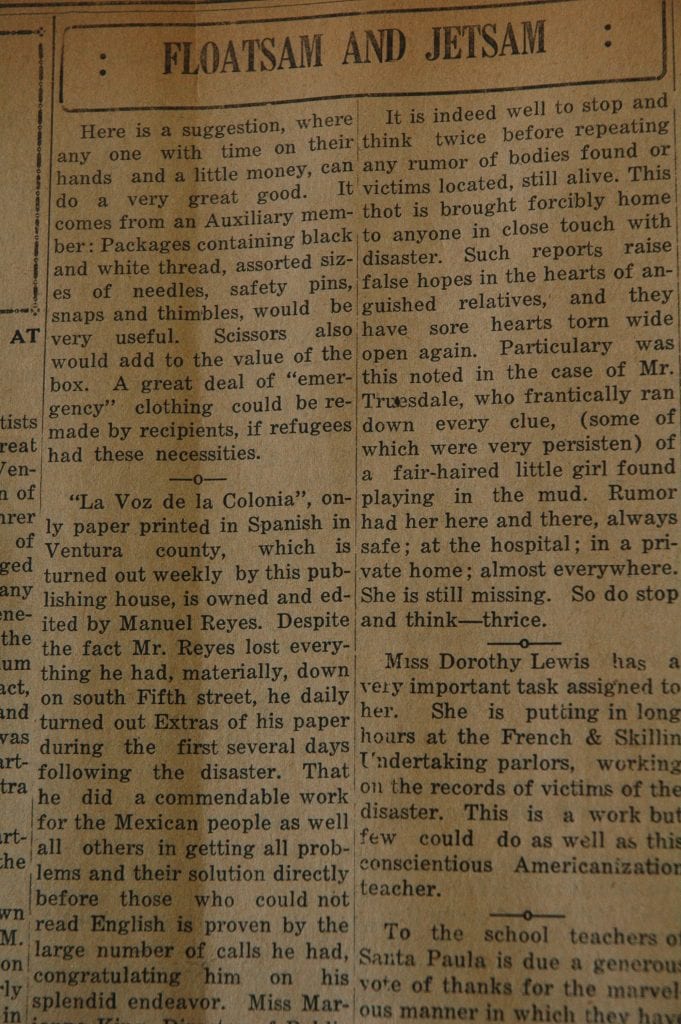
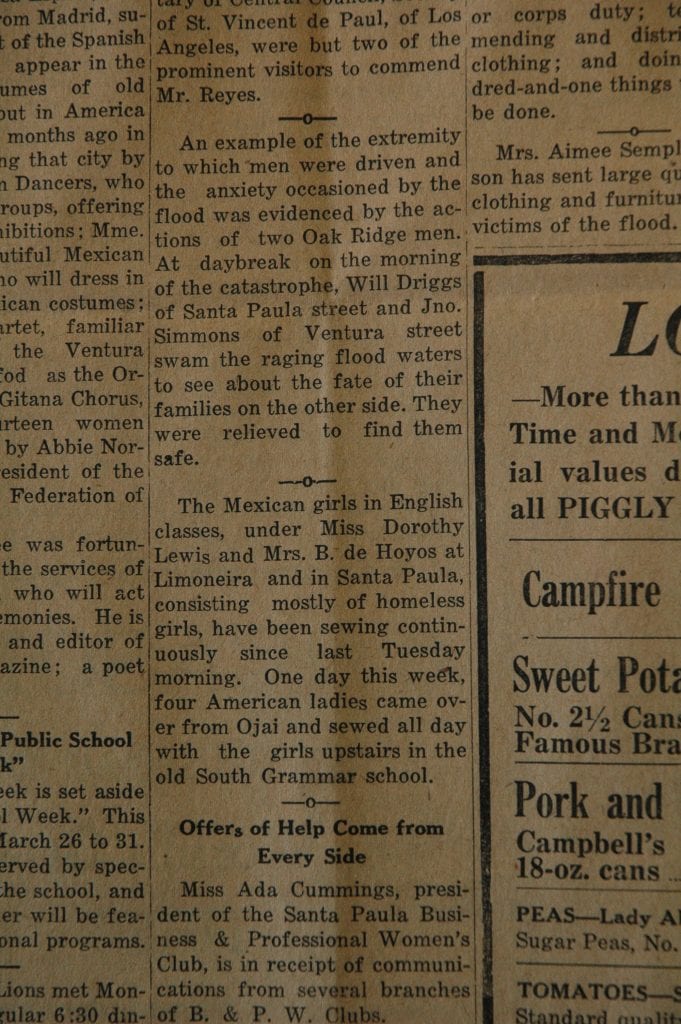
From the Fillmore American, Thursday, March 22, 1928, page 4
Many Funerals From Bardsdale Church
Re. Palmer, of the Bardsdale church, was bury with the melancholy task of laying flood victims to rest from his little church in the orange groves. Seven were buried from there, beginning with the funeral services of George Basolo last Friday afternoon. The services for Mrs. Kelly and her children were conducted by Rev. W.O. Ogden, of the Fillmore Brethren church, of which Mrs. Kelly was a member.
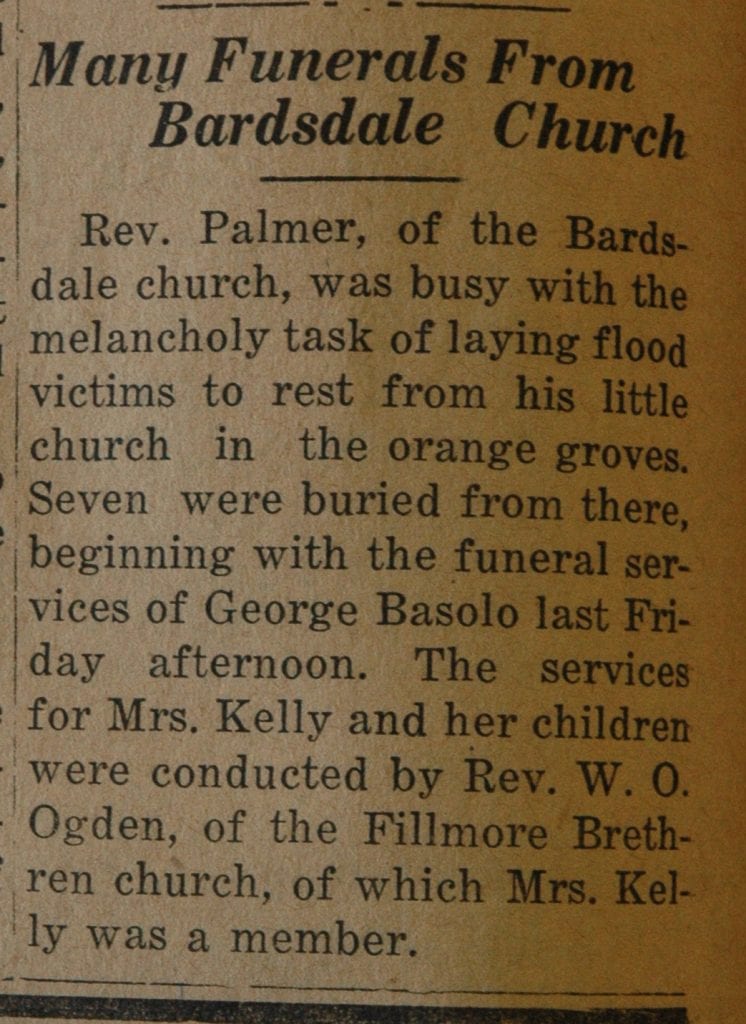
From the Fillmore American, Thursday, March 22, 1928, page 4
Offers of Help Come from Every Side
Miss Ada Cummings, president of the Santa Paula Business and Professional Women’s Club, is in receipt of communications from several branches of B. & P.W. Clubs.
One of the first offers of assistance came from Oxnard, followed by letters from Santa Barbara, Eagle Rock and several others. A letter dated the day following the disaster was sent by Mrs. Una R. Winters, President of the Southern District. She had been informed of the flood by the Averys, and her letter, in part follows: “I feel that I want to extend the sympathy of the membership of Southern District to the Santa Paula Club for the unfortunate catastrophe that has happened in your near vicinity…
“I am thankful that we have our Red Cross Chapters all over the state and country, ready with money and materials for immediate aid to the sufferers. And we are all ready to help later on-if need be. If there is anything that our organization can do to help the members of our club in Santa Paula let me know.”
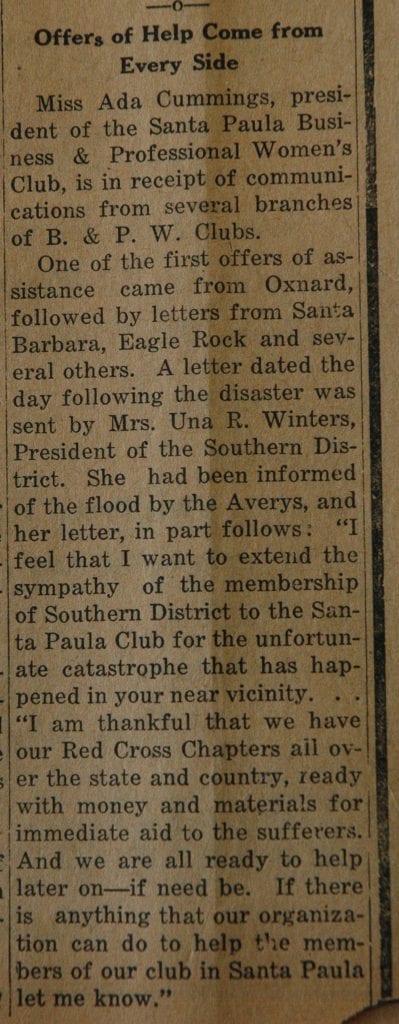
From the Fillmore American, Thursday, March 22, 1928, page 5
BULLETIN NO. 1
NOTICE TO ALL PROPERTY OWNERS WHO SUFFERED DAMAGE BY THE FLOOD FROM THE ST. FRANCIS RESERVOIR
The Board to Supervisors of Ventura County has appointed a committee of citizens to ascertain the amount of damage to property caused by the flood from the St. Francis Reservoir on March 13, 1928. The committee has established headquarters in the Court House at Ventura in the office of County Surveyor. All property owners are asked to make an estimate of the amount of their loss. An itemized list of the loss should be prepared covering the following:
- Location of property on which loss was sustained so that it can be indicated on the maps of the committee.
- Inventory of all personal property lost or damaged and the cost of replacing or repairing the same.
- Inventory of improvements to real property and the cost of replacing or repairing the same.
- Inventory of all growing crops damaged or lost.
- Inventory of all damage to real property and a description of the character of damage.
The committee is not considering damages due to personal injuries or loss of life.
It is recommended that property owners repair their own damage where possible. A careful and itemized record of the cost of these repairs should be kept and filed with the committee.
If an estimate of loss is filed at the present time it can be amended later when detailed costs are available. Land owners and tenants will be expected to use all diligence in repairing damage to farm lands so that the present crop season will not be lost.
Blank forms for claims will be prepared by the committee and may be obtained at the following places:
- County Surveyor, Ventura
- City Clerk, Fillmore
- City Clerk, Santa Paula
- City Clerk, Oxnard
- Local committee headquarter, Piru
It is advisable that each claim be supported by two or more witnesses who are familiar with the items of the claim, or by copies of receipted bills or labor pay rolls, or any other evidence that the owners can support. Each claim should be signed before a Notary or public official. Claims my be filed at any of the offices listed above. The committee is negotiating with the City of Los Angeles for settlement of damages and it will see that all claims receive proper consideration.
This notice issued by order of the committee. CHARLES W. PETIT, GEO. C. POWER, D.J. REECE, RICHARD BARD, CHAS. DONLON, FRED NOBLE, S.D THACHER, C.C. TEAGUE, A.C. HARDISON, ROGER EDWARDS, JOHN B. MCNAB, C.C. PERKINS, A. CAMARILLO, M.H. BUTCHER

From the Fillmore American, Thursday, March 22, 1928, page 5
Faultless Service Rendered by Gas Co. During Recent Flood
Little did the housewives in this section of Southern California realize when they prepared the family breakfast on the gas range Tuesday morning, March, 13th, that just a few hours before, the breaking of the St. Francis dam had taken out four major gas lines leading into this section–two lines from Bakersfield and two from Ventura; these four lines were delivering gas into the southland at the rate of 150,000,000 cubic feet every twenty-four hours. Yet, during the emergency, the local gas company was able to give satisfactory service from their storage holders.
At 2:45 a.m., that Tuesday morning, the Southern Counties Gas Company’s Compressor Plant at Ventura notified the Whittier district that the Ventura – Whittier line was broken somewhere in the 85 mile stretch. At that time Ventura did not known as yet what had caused the trouble.
A repair crew left Whittier at 3:20 a.m. to locate and repair the break. A.F. Bridge, Executive Engineer for the Southern Counties Gas Company, was notified in Los Angeles a few minutes later, that the St. Francis dam had gone out and considerable damage had been done.
When the extent of the damage was determined, two more repair crews were sent north from Whittier and one from Santa Monica.
Men and material were transported over a treacherous mountain road through the Newhall ranch to Kemp station where 950 feet of the 12 inch line over the Santa Clara river had gone out. The steep and dangerous turns on this road were such that it took the trucks two hours to make this ten-mile trip, loaded to only one-third their rated capacity.
Wednesday morning at 7:30 a.m. the actual laying of the emergency line was commenced and at 6:30 that evening this portion of the line was replaced. In the meantime it was discovered that there were two breaks in the line between this point and Ventura, one of 00 feet and one of 200 feet. Only small damage, however, has been done to the Midway Gas Co.’s line to this point, so the emergency crews of the Southern Counties Gas Co. at Ventura with the assistance of the Ventura Fuel Co.’s men, worked with the Midway repair crew, and on Thursday noon this line was in service as far south as the Southern Counties’ new emergency river crossing. At 7 p.m. Thursday March 15th, gas was again flowing south from Ventura at the rate of 28,000,000 cu. ft. per day thru this one line.
Within six hours after the disaster, normal service was established in the Santa Clara River Valley.
In addition to the Ventura-Whittier lines, the local gas comopany suffered breaks in four other lines in Ventura Co., but these and all the other gas lines from Ventura and Bakersfield were back in service by Sunday, March 18th.
F.S. Wade, vice president and manager of the Southern California Gas company in Los Angeles, was impressed with the splendid work and loyalty of the workers.
Some of the workers were on duty 58 hours.
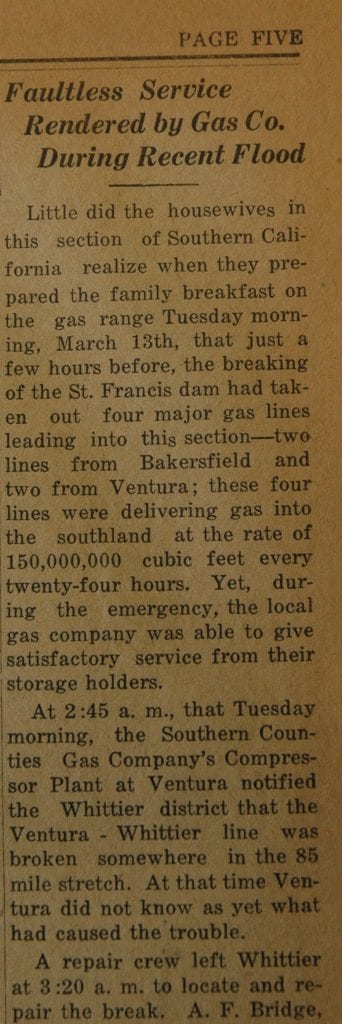


From the Fillmore American, Thursday, March 22, 1928, page 5
Who Sounded Tocsin in Santa Paula?
It is interesting to know just how the alarm of the onrushing flood waters was given in Santa Paula.
The call came from the Sheriff’s office to Constable John Messer at exactly 1:30 a.m. Deputy Sheriff Chrisman was so excited, Mr. Messer could not understand him readily, so Undersheriff Ayala finished the warning. Mr. Messer rushed madly up town and together with John Buck, opened San Primmer’s store and called Chief of Police Lee Sheppard, State Motor Officer Thornton Edwards, Motor Officer Stanley Baker and Fire Chief Sam Primmer. Mrs. Louise Gipe was the night operator at the switchboard and it is due to her speedy and efficient work that a large number of people owe their lives. It is to be further remembered that connections on the switchboard were made by dim light or automatically, as the electric power was off.
Constable Messer then raced up to Stanley Lothridge to see about the light problem. Together these two turned their first attention toward warning the sleeping victims in the low lands, leaving the power question until after the waters were receding.
The Sheriff’s cars began to arrive in Santa Paula area about the same time the local police force and motor officers started sounding the tocsin.
In his work during this terrible disaster, Constable Messer had added a fine feather in an already well decorated hat for services rendered. By no means did his endeavors and with notifying those in danger–he worked two days in the river bed, which is very familiar to him, and was near collapse from exhaustion after three days more spent in the undertaking parlors.

From the Fillmore American, Thursday, March 22, 1928, page 6
Now Phyllis Comes No More
by William Hamilton Miller
When Phyllis comes to visit me My esctacy’s untold; For Phyllis’ eyes are bonnie blue, And Phyllis’ hair is gold.
When Phyllis comes to visit me We sit upon the grass; And as she sweetly lisps to me The time doth swiftly pass.
Now Phyllis is as frank as fair, I’ll pledge my word on that; And often sweetly says to me: “My, ain’t you awful fat?”
Yet Phyllis likes me passing well, I’d ask of maid no more; And I forgive her frankness, quite, For Phyllis is but four.
It seems as though it were but the other day that I wrote those imperfect lines. Yet the files show that it was printed in my column in the Fillmore American on June 10, 1926.
And when I wrote them there was only joy in my heart, at memory of the romp on the grass with the little golden-haired daughter of my neighbor, Hezikiah Kelly, just across the fence. There was no thought of death of tragedy about to touch us anywhere in the immediate future. Unless away back there in the very back of my mind there might have been an unthought thought that sometime in the far distant future, when Phyllis had grown to beautiful womanhood, she might some day drop a tear if she heard of the passing of the fat old fellow who played with her that Sunday afternoon on the little grass plot, there where the houses are crowded thick along Santa Clara street.
For it was a bit crowded there. The Kellys living in a little green house that fronted on Santa Clara street. My own little house back on the alley. In front the home of Mrs. Caroline Cummings. The little bit of grass wedged in between the three.
And sometimes Mrs. Cummings, straight and slender despite her more than three score years and then, gray haired and alert, would look out at us with just the faintest trace of a smile. Bearing her widowhood with the same fortitude that had brought her through this vicissitudes of a long life.
And now the awful calamity that in a twinkling of an eye carried Phyllis away with mother, brother and sisters, in dark and swirling waters. Casting her little body up to rest beside that of her mother and a sister there in the beautiful little cemetery, up on the mesa at Bardsdale. And the gray-haired old woman, who watched us that Sunday from the house in front, bearing the added sorrow that comes of loss of son, and daughter, and granddaughter.
And that state of affairs is duplicated in some greater or less degree in hundreds of homes up and down this wave wrecked valley, where just such a short time ago there was peace, and happiness, and contentment.
And where ever such bereavement has come there are broken hearts and sore. And my own heart goes out in deep, though wordless, sympathy to every stricken home, where Phyllis–or someone equally well beloved–will come no more.

From the Fillmore American, Thursday, March 22, 1928, page 6
WE ARE FUNDAMENTALISTS ALL
Would that I could paint a picture of that impressive funeral ceremony over in Santa Paula cemetery Monday afternoon. But no mortal could paint such a picture unless he might dip his brush in the same pigments that are used by the Great Artist who tints the blue bird’s wing, touches the autumn leaves with brown and gold, and limns a million sparkling gems of light upon a cloudless midnight sky.
And that great crowd that stood in solemn stillness there–united in the brotherhood of sorrow that drives all of us to our one common Father. No difference of religious thought was there, each soul stood stripped to his or her fundamental belief in the One Great God. There was every form of livery in which man has sought to serve his Maker–the brown robe of the friar, the black coat of the parish priest, the vestments white and black, the modern garb of the present-day minister, and the bright uniforms of the fire and blood soldiers of Salvation. But all religious creeds were as but scraps of paper, all church vestments but so many fluttering bits of cloth. And no man was rich, and no man was poor, in the plentitude of sorrow that dowered them all. And no man was learned and non man was ignorant. And only they were wise, and able to find consolation, who could say: “I know that my Redeemer liveth.”

